- Cat Behavior
- Health & Care

Average Cost of a Vet Visit for Cats in 2024: How Much Should I Expect to Pay?
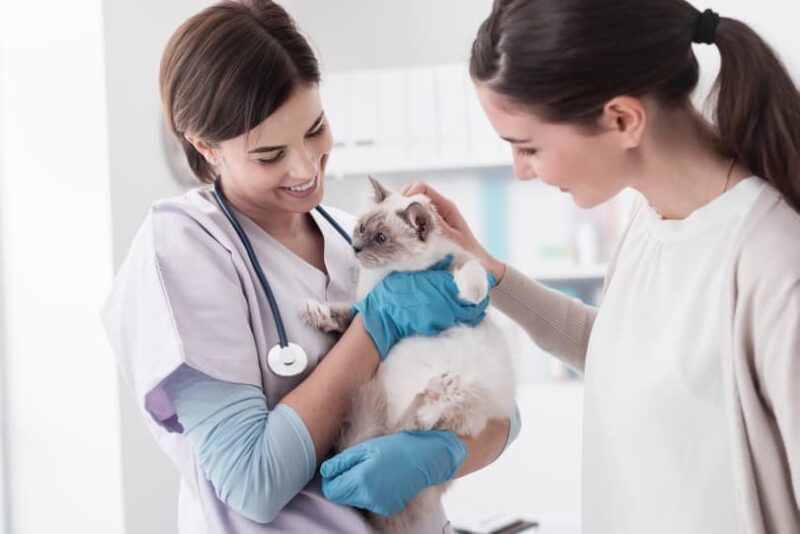
Image Credit: Stock-Asso, Shutterstock
Last Updated on April 25, 2024 by Catster Editorial Team
Cats require love, discipline, protection, and high-quality food to thrive. They also need to see the veterinarian regularly to ensure their health stays strong throughout their life. It is easy to tabulate how much food, bedding, and toys will cost you as time goes on. But how much will it cost to get your cat veterinarian care in the coming years? Here is everything you need to know about the average cost of a vet visit for cats this year, which can be between $40 and $150, however, certain procedures will be more costly than the cost of a general checkup .

- How Much Is a Vet Visit for a Cat?
There is no way to know precisely how much a visit to the vet with your cat will cost because it depends on many things, including the reason for the visit, the types of tests that may be done, and how long the visit takes overall. It also depends on where you live and what type of animal care facility you decide to visit.
A basic checkup, sometimes referred to as a wellness exam, typically consists of an oral “interview,” where your vet will ask questions about things like how well your cat is eating and drinking, the amount of exercise that they get daily, their litterbox habits, whether they have been in any catfights or accidents recently, and their overall behavior.
After the question-and-answer period, your vet will complete a physical examination of your cat, checking their bones and muscles to ensure that no unseen injuries are present. They will also check how alert your cat is, the quality of your cat’s coat, and the condition of their teeth. Ear and nose discharge, eye cloudiness, and abnormal body lumps will also be examined.
A basic checkup can cost anywhere between $40 and $150, depending on where you live. You may need to see a veterinarian for reasons other than just a checkup, in which case, the cost of seeing the veterinarian may differ significantly. Here is a chart of a few service examples and the average cost per region.
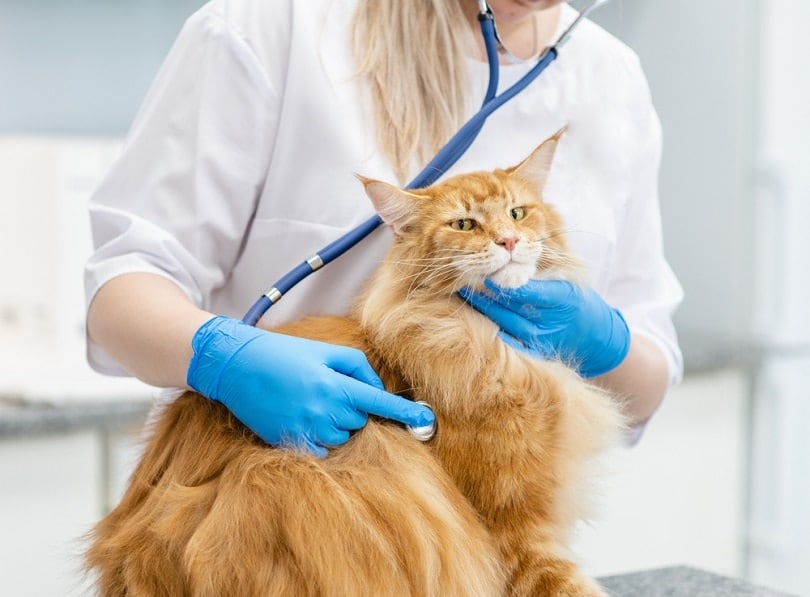
- Standard Vet Procedures by Region
Source: https://www.banfield.com/Services/price-estimator
- Additional Costs
In addition to the basic service options, we can address other specific services, so you have a ballpark idea of how much each may cost.
- Tooth Extractions
One or more of your cat’s teeth may need to be extracted due to problems such as crowding, fractures, or an abnormal bite that affects their ability to eat food. Tooth decay and disease can also result in the need for an extraction.
The cost of tooth extraction for cats can be anywhere from $250 to more than $1,000, depending on the type of extraction and the types of medications and tools used during the extraction process.
- Geriatric Screening
Cats over the age of 7 should get regular geriatric screenings. This type of examination is more comprehensive than a wellness checkup and typically includes bloodwork, a urinalysis, and, if necessary, X-rays. Each geriatric checkup could cost between $75 and $200, depending on the services you choose to include in your cat’s geriatric package.
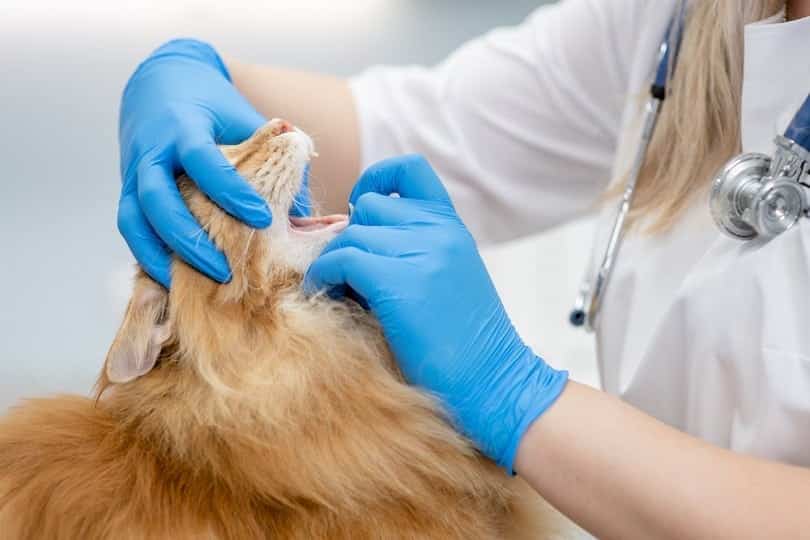
- Allergy Treatments
Allergy treatments involve more than just prescribing medication. Your veterinarian will have to test your cat for allergies to figure out what is causing their allergic reactions. Once a cause is determined, they can determine the best course of action to help your cat avoid or fight off the cause of their allergies. Therefore, you can expect allergy treatments for your cat to cost between $300 and $1,000.
Cats are susceptible to becoming infected with intestinal worms, especially if they spend any of their time outdoors. Unfortunately, multiple parasites could find a home in your cat’s body. These include roundworms, hookworms, and tapeworms.
Luckily, your cat can be treated for worms at the vet’s office. Your vet will first do a fecal test to determine exactly what type of worms your cat is infested with, which can cost between $30 and $80. Medication to treat the worms should cost less than $25.
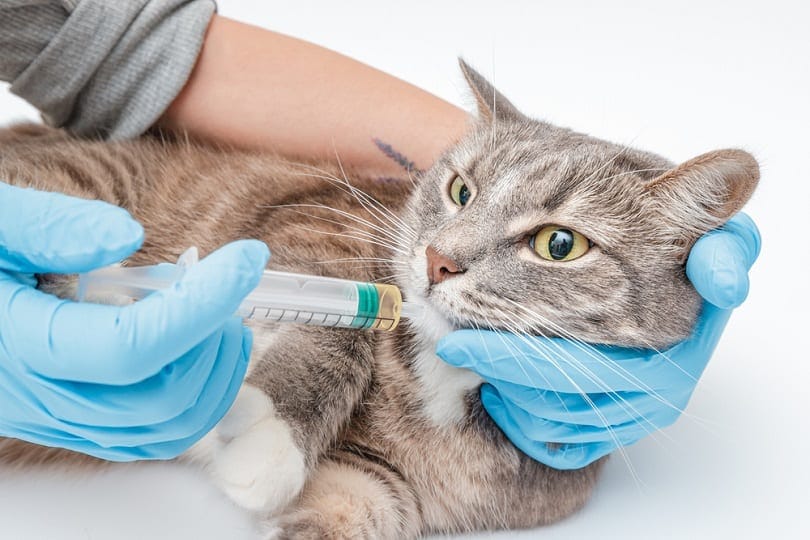
- Eye Surgery
If your cat develops cataracts, develops cherry eye, or has entropion, they may require eye surgery. Unfortunately, no type of eye surgery is inexpensive. For example, removing cataracts and completing similar procedures could cost up to $3,000. The average cost of less invasive and laborious eye surgeries is about $1,400. These are just a few examples of how much a vet visit for a cat without insurance could cost you.

- What to Expect Financially From an Emergency Vet Visit
You never know when you might need to take your cat in for an emergency visit, whether because they get injured, become ill, or ingest something they should not. The cost of just walking in the door to see a vet due to an emergency is between $75 and $150. However, costs do not stop there. Depending on the situation, you could face charges for one or more of the following services.
- Diagnostics
Diagnostic tests can include blood work ($75–$200), an X-ray ($150–$250), and an ultrasound ($300–$600). Overall, you could be looking at anywhere from $75 to $1,000 for diagnostics alone.
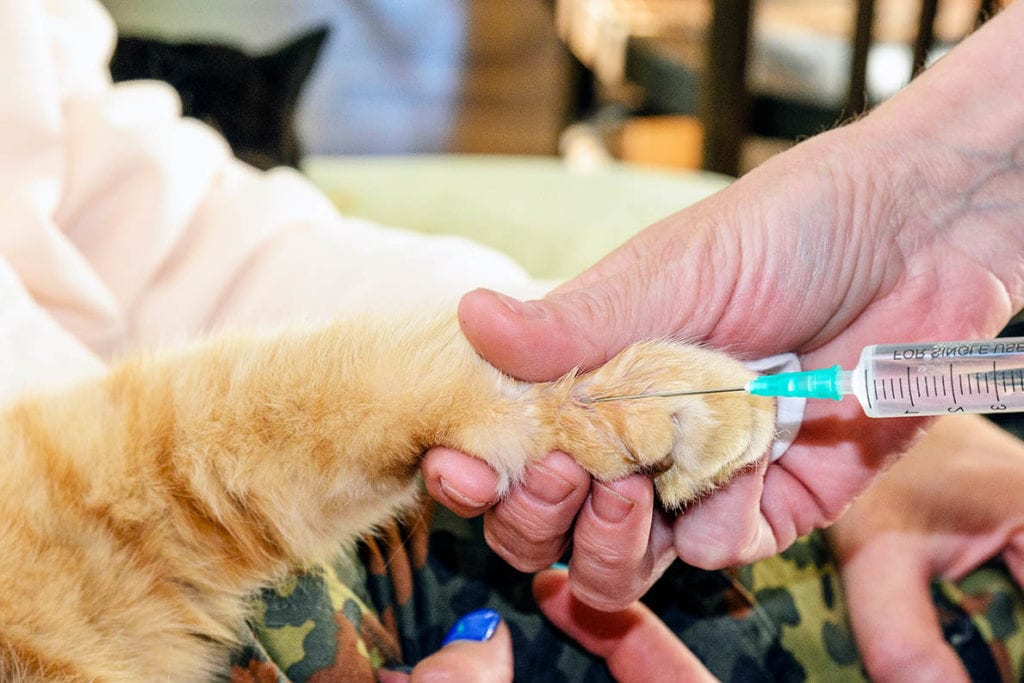
- Hospitalization
Twenty-four hours of hospitalization for your cat could cost upward of $1,500, not including any treatments or services rendered during that time. The longer your cat must stay hospitalized, the less expensive each day of hospitalization becomes. So, if your cat is hospitalized for five days, you could pay about $3,000.
Being hit by a vehicle, developing bloat, or ingesting a foreign body are just a few reasons your cat would need emergency surgery. While there is no way to know exactly how much surgery will cost until you know the reason, you can expect to pay between $1,500 and $4,000.

- Which Vet Bills Do Pet Insurance Companies Cover?
With the average cost of a vet visit for your cat being so high, many companies sell pet insurance to help cover the costs of veterinarian services they receive throughout their life. Most pet insurance companies cover a percentage of the bill for emergency , accident, and sudden illness vet services in exchange for you paying them a monthly premium. For an extra monthly fee, some insurance companies will cover the costs of preventative care, including wellness exams, deworming, and flea treatments, minus a deductible.
Most companies offer reimbursement plans, which means that they will pay you back after you pay for the veterinarian services yourself. However, depending on the insurance company and the vet you are working with, you may be able to score a plan that does not require you to pay for services out of pocket.
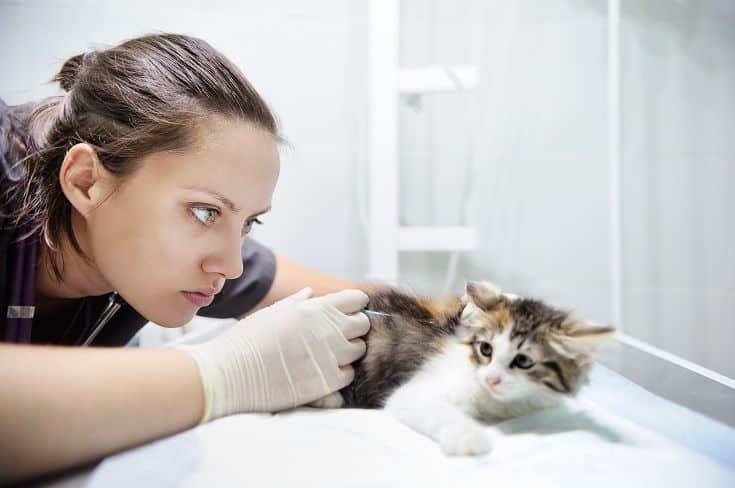
- How Often Should I Take My Cat to the Vet?
Kittens and cats should see a veterinarian once a year for a wellness checkup and any required vaccinations. Flea and deworming treatments can be done at home and require nothing more than a quick stop to pick medications up from the vet when necessary (usually monthly for regular flea treatments).
Once your cat reaches the age of 7, your veterinarian may suggest that you come in for wellness checkups twice a year, as changes in a senior cat’s health can happen quickly.
Now that we’ve given you the average cost of a vet visit for your cat, it’s obvious that veterinarian care is not cheap, but it is necessary. Your cat cannot experience a happy, healthy, high-quality life without regular checkups and proper vaccinations. Even cats that live exclusively indoors need to be vaccinated, as they are not completely protected from a disease that thrives outside. We hope that our guide helps prepare you for any veterinarian visits that you make with your cat in the future.
- North West Animal Eye
Featured Image Credit: Stock-Asso, Shutterstock
About the Author
Rachael Gerkensmeyer
Rachael has been a freelance writer since 2000, in which time she has had an opportunity to research and write about many different topics while working to master the art of fusing high-quality content with effective content marketing strategies. She is an artist at heart and loves to read, paint, and make jewelry in her spare time. As a vegan, Rachael is obsessed with helping animals in need both in her community and anywhere in the world where she feels she can make a difference. Animals also happen to be her favorite topic to write about! She lives off the grid in Hawaii with her husband, her garden, and her rescue animals including 5 dogs, a cat, a goat, and dozens of chickens.

Zumalka Pet Supplement Review 2024: A Detailed Look

10 Pet-Friendly Hotels in St. George, Utah (2024 Update)

Does Health Monitoring Cat Litter Work? Vet Reviewed Facts & FAQ
Get catster in your inbox.

Here Comes the Sun: Is It Alright? Dangerous Things Cats Like

Cat Dogs: Cats for People Who Think They Don’t Like Cats

Strange Places That Cats Hide: Olga’s Preferred Spots
© pangolia pte. ltd. all rights reserved..

How Much Does a Vet Visit Cost? Here's Everything You Need To Know

When you’re ready to adopt a pet, you may not always be thinking about their future veterinary costs. But it’s important to consider vet fees when working out your budget for caring for your pet over the next several years.
Not only will your pet need food, grooming, toys, and other supplies, but they’ll need to go to the vet at least once per year. You may also need to pay for emergency services if your pet gets hurt or sick, and those can add additional strain to your budget.
But how much does it cost to go to the vet ? Unfortunately, the answer is: “it depends.” While most regular vet services can cost $100 or less, some procedures and treatments can cost thousands.
As a pet rescue and foster who works with a pet rescue nonprofit in Brooklyn, I've seen my fair share of veterinary bills - ranging from low-cost "mom-and-pop" practices to higher-end practices with state-of-the-art diagnostics and surgeons.
Here, I’ll break down what you can expect when taking your pet to the vet:
- The basic costs involved in a vet visit
- Standard veterinary expenses
- How pet type can influence the costs of a vet visit
- How breed can influence vet costs
- What to expect from a visit to the vet
- Potential fees associated with emergency vet visits
- How to cover veterinary costs without depleting your savings
- Key Takeaways
- Frequently Asked Questions
The Basic Cost of a Vet Visit
According to the American Veterinary Medical Association (AVMA), the price of veterinary services has been rising steadily since the turn of the millennium. In 2016, the Veterinary Services Price Index was outpacing the Consumer Price Index by more than 25 percentage points .
Pet ownership is increasing, and the costs of veterinary care are also on the rise.
Veterinary care is in much higher demand than it ever was, in part because pet owners are treating their pets differently. In one study, 95% of pet parents consider their pets a part of their family. People are spending more on their pets, and they’re more willing to bring them to the vet for regular checkups.

A Breakdown of Standard Veterinary Expenses
Vet expenses vary widely depending on what services your veterinarian is providing. Veterinary practices charge for services like physical exams, diagnostic services, lab work, surgical procedures, anesthesia, hospitalization, and even overnight boarding.
Many of these services can be covered by pet insurance , which would reimburse a percentage of your out of pocket expenditures after you pay your vet.
An appointment for surgery will cost much more than a wellness visit, and regular treatments, such as those for cancer, can add up to a considerable sum over time. Here are some of the most common veterinary services and how much they typically cost.
Tests, Examinations, and Initial Vet Costs:
- Routine checkups: $50 to $250
- Spay/neuter: $160 to $220
- Vaccines per shot: $15 to $28
- Physical exams: $45 to $55
- Fecal exam: $25 to $45
- Heartworm test: $45 to $50
- Dental cleaning : $70 to $400
- Allergy testing: $195 to $300
- Geriatric screening: $85 to $110
Surgeries and Unexpected Vet Costs*:
- Bloodwork: $80 to $200
- X-rays : $150 to $250
- Ultrasounds: $300 to $600
- Short hospitalizations: $600 to $1,700
- Long hospitalizations: $1,500 to $3,500
- Wound treatment: $800 to $2,500
- Emergency surgery: $1,500 to $5000
- Oxygen therapy: $500 to $3000
(*Based on estimates by Emergency Vets USA )
Again, these prices may vary depending on where you live, what type of animal you have, what breed you have, and their health history. Even a routine exam fee can vary state-by-state. According to the ASPCA , recurring medical expenses for a dog can range from $210 to $260 depending on their size.
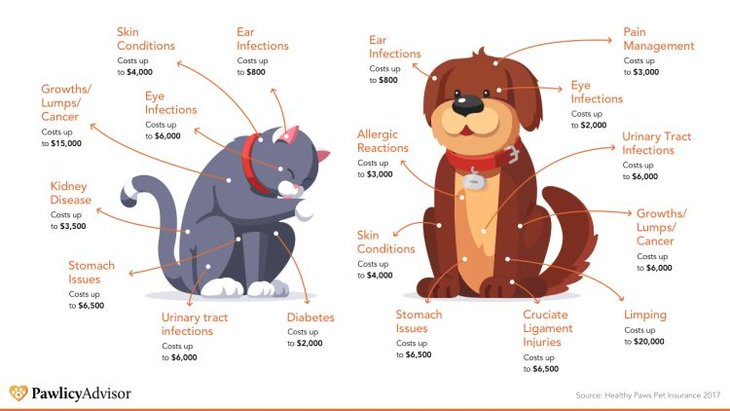
The good news is that you can lower the costs of these services significantly with pet insurance . For example, if you have a pet insurance plan that reimburses you for 90% of covered costs, that $5,000 emergency surgery could end up costing you just $500 out of pocket.
Pet insurance lowers out-of-pocket vet costs.
Plans can reimburse 60-100% of eligible expenses.
Average Vet Costs for the First Year of Owning a Dog or Cat
The APSCA estimates that the first year of owning a dog can cost as much as $2,000 or more , depending on the size of the animal. Meanwhile, the cost of owning a cat can cost up to $1,174 on average.
However, these costs are assuming you’ll only need to bring your pet in for regular visits and won’t have any unexpected charges on your vet bill. If a regular visit costs about $250 and you bring a new dog to the vet only once, the rest of your spending can go to supplies like food, toys, and treats.
If your pet needs some of the unexpected services listed above because they develop an illness or need additional tests, you could end up paying substantially more out of pocket if you don’t have pet insurance.
How Pet Type Can Influence the Costs of a Vet Visit
It’s difficult to nail down the costs of vet care because veterinary medicine differs depending on the type of pet you own. Caring for a smaller animal like a cat or rabbit is generally much less expensive than caring for a large or medium-sized dog — or a horse, for that matter.
Today’s pets are also living longer than ever thanks to advances in medical care and better pet diets. If you have an older pet , you can expect to have higher veterinary costs because pets tend to need more care as they age. Older pets should get regular veterinary examinations so your vet can check for problems.
AVMA notes that “while it’s easy to spot the outward signs of aging such as graying haircoat and slower pace, it’s important to remember a pet’s organ systems are also changing. An older pet is more likely to develop diseases such as heart, kidney and liver disease, cancer, or arthritis. Dogs get cancer at roughly the same rate as humans, while cats have a somewhat lower rate.”
Other factors that can influence veterinary costs are your pet’s weight, health history, and temperament . For example, if your dog is overly aggressive when you bring them to the vet, you may need to give them medication to keep them calm and muzzle them. In some cases, the vet may need to sedate your pet so they can examine them, which can add to your costs.
How Breed Affects Veterinary Costs
The breed of your pet also impacts veterinary costs. When discussing breed, we’re generally discussing dogs.
There are over 190 recognized dog breeds in the United States and only 42 cat breeds. This is partially due to the history of dog breeding and how dogs were used as herders, hunters, and other types of working animals in the past. Still, some cat breeds do have fewer health issues than others.
Many pet insurance plans cover breed-specific issues. If you have a pet breed that tends to have certain conditions, investing in pet insurance could help significantly if those conditions arise.
Some common breed-specific conditions include the following:
- Bladder stones
- Brachiocephalic syndrome (due to narrow nasal passage)
- Ear infections
- Hip dysplasia
- Knee and elbow dislocations
- Slipped discs
If you’re unsure about your pet’s breed-specific conditions, ask your veterinarian about what you can expect.
What to Expect From a Visit to the Vet
A typical visit to the veterinarian can cost as little as $50 depending on the pet being examined and their needs. But, as we mentioned before, those costs can go up if your pet has an unexpected illness or if they need other types of routine care.
Your First Visit
On your pet’s first visit, your veterinarian will conduct a general health screening and wellness exam. They’ll enter your pet’s information into their records. You can expect them to do the following:
- Weigh your pet
- Listen to their heart and lungs
- Take their temperature
- Check their ears, eyes, and genitalia
- Examine their teeth and mouth
- Examine their feces (you may need to bring a sample)
- Give your pet vaccinations (if necessary)
- Test for common diseases (if necessary)
- Determine your pet’s vaccination schedule
The Wellness Exam
Similar to an initial health screening, a wellness exam determines the overall health of your pet. Your regular veterinarian will do a physical examination of your pet, but they’ll also ask you questions about your pet’s behavior, diet, and lifestyle patterns.
A basic vet visit might cost $50, but expenses quickly add up with illnesses and injuries.
For example, it’s normal for dogs to curl up and sleep throughout the day, but if your dog is acting particularly lethargic, this could be a symptom of an underlying condition. Your vet would need to know about this behavior.
Similarly, even the healthiest cats will vomit from time to time . But if they are vomiting often — more than once or twice per week — it could indicate a health condition. This is why it’s important to be completely open about your pet’s behavior with your vet .
Once your veterinarian has assessed the wellness of your pet, they’ll discuss preventative steps you can take to avoid problems. They may recommend you use preventive treatments for fleas, ticks, intestinal parasites, and heartworm. They’ll go over your pet’s nutrition needs, weight management, what pet food you should use, dental care, and more.
Scheduling Routine Check-Ups
Most veterinarians recommend you bring your pet to them at least once per year, but preferably more. Unfortunately, some pet parents bring their pets to the vet less often.
According to a study by the AVMA , about 8% of pet parents don’t bring their pets in for routine checkups once per year. Still, 51% bring them in once per year and the remaining 41% bring them even more often.
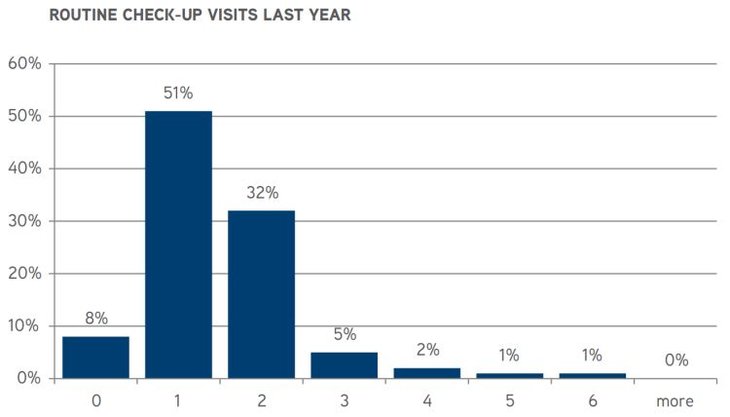
Over 50% of pet owners took their pet to the vet for a routine checkup at least one time in the previous year.
A routine check-up will typically involve a physical examination, a wellness check, and vaccine booster shots, if necessary. If you want to be reimbursed for this kind of routine care, you'll need a wellness plan .
Unexpected Veterinary Costs
If your veterinarian discovers anything out of the ordinary during your pet’s first visit or a subsequent wellness exam, they may wish to do additional tests to determine what’s wrong with your pet.
Generally, veterinarians will only do additional testing if they need to narrow down the possibilities of your pet’s condition to make an accurate diagnosis. Don’t hesitate to ask about the costs of testing beforehand . Once your veterinarian is confident in their diagnosis, they’ll discuss plans for treatment with you.
If your pet is sick or injured, you’ll have to pay some unexpected veterinary costs. This is where pet insurance is essential . Depending on the severity of your pet’s condition, you could have to pay thousands of dollars out of pocket to treat your pet.
If your pet needs life-saving care, they may be admitted to an animal hospital overnight. You’ll need to pay for the boarding of your pet, for any tests conducted to determine what’s wrong, as well as for treatment to make your pet better.
Pet insurance coverage means you only have to pay for a fraction of what you’d normally owe in vet bills.
Health Issues & Vet Costs to be Aware of
- Dog Teeth Cleaning
- Kennel Cough
- Heartworm Disease
- Lyme Disease
- Leptospirosis
- Dog X-Ray Costs
Potential Fees Associated with Emergency Vet Visits
An emergency visit occurs when your pet needs immediate or life-saving care and they can’t wait until regular business hours for an appointment. Thankfully, many veterinary clinics and animal hospitals provide out-of-hours veterinary care for emergencies. If you’re a new pet owner, you should identify your nearest emergency clinic just in case.
If your pet has an emergency, contact your veterinary emergency services provider immediately and speak to the person on-duty. They’ll give you advice over the phone, or they’ll suggest you bring your pet in for treatment.
After your pet is examined, the emergency care vet will discuss whether they need to do additional tests or whether you can move on to treatment. It’s at this point that your costs will begin to go up.
Emergency veterinary fees are typically higher than fees associated with regular care. According to Preventive Vet , a typical emergency visit may involve the following fees:
- ER exam: $75 - $125
- IV catheter: $60 - $75
- IV fluids : $50 - $75
- Blood tests (basic): $75 - $150
- Urine tests (basic): $25 - $50
- X-rays (basic): $75 - $250
- Blood pressure measurement: $25 - $75
- Pain medication: $40 - $80
- Hospitalization / Vet Tech Monitoring: $50 - $200
TOTAL: $475 - $1,080
This is not including any additional costs for treatment, which is dependent on your pet’s condition. This is why the costs of emergency veterinary care vary so much. It’s also the reason financing options and pet insurance are so important during emergencies.
How To Cover Veterinary Costs Without Depleting Your Savings
Clearly, comparing pet insurance options is a must. With a comprehensive pet insurance plan, you won’t have to worry about choosing between your pet’s emergency care and breaking your bank. Good coverage ensures you can get them the care they need right when they need it and gain peace of mind in knowing your prepared for an emergency ( even for rescue pets ).
However, pet health insurance works differently than human health insurance . Most pet insurance providers pay you, the policy holder, instead of the practice or doctor. That means you don't have to worry about find a veterinarian who's "in-network", you can go to any vet you please and get reimbursed just the same - but that also means that you will generally have to pay the cost upfront while you wait for your reimbursement.
Ideally, you should pay for the upfront vet cost on a credit card with a good rewards incentive. For example, if your credit card offer 3% cash back on purchases, by using that card to pay the initial bill you'll be effectively reducing the cost by 3%. Then, in just a few days your pet insurance provider will reimburse you for the bill and you can pay off that credit charge with the reimbursement.
For example, let's pretend you have a policy with 90% reimbursement and a $250 deductible...
Your vet bill is $1237, you put it on your credit card which give 3% cash back. Your plan reimbursed you for 90% of the cost after the deductible is met. In this case, let's say it's the first vet cost of the year so your $250 deductible is not yet met. Eight days after paying your vet bill your pet insurance provider reimburses you $888.30 (or ($1237 - $250)*0.9).
Your total cost would then be: $1237 - $888.30 - (3% back on $1237) = $311.59
That's a massive savings. And, if another issue arises your deductible is already paid for that year so you'll simply be reimbursed 90% (or what ever your policy indicates) on your next bill.
For example, vet bill #1 cost $1237 but it only cost you $311, then vet bill #2 comes in for $600 but it only costs you $42! Since your deductible was paid for in vet bill #1, you'll be reimbursed 90% of the full vet bill #2 plus 3% back on the initial bill (if you used a credit card with that reward rate)... $600 - 90% (or $540) - 3% (or $18) = $42.
This way, your bank account goes untouched and your savings are maximized.
Just make sure you get the right pet insurance policy at the best price, no matter the provider .
Do you want to find the best pet insurance?
Let's analyze your pet's breed, age, and location to find the right coverage and the best savings. Ready?
About Pawlicy Advisor
The pet insurance marketplace endorsed by veterinarians, at Pawlicy Advisor we make buying the best pet insurance easier. By comparing personalized coverage and pricing differences we can save you a ton of money, up to 83% in some instances!

Instantly Compare Pet Insurance Plans
How To Compare Plans
Determine If Pet Insurance Is Worth It
Determine If Wellness Plans Are Worth It
Vet Visit Costs
New Puppy Checklist
Comparison Charts
ASPCA vs. Pets Best
Pets Best vs. Embrace
Embrace vs. Pumpkin
Pumpkin vs. MetLife
More Comparison Charts
Find Your State
Pennsylvania
More States
Dog Insurance
German Shepherd
English Bulldog
French Bulldog
More Breeds
.css-3sl4ml{color:#E26C33;-webkit-text-decoration:none;text-decoration:none;}.css-3sl4ml:hover{color:#E26C33;-webkit-text-decoration:underline;text-decoration:underline;} Edwin Plotts .css-aqd080{font-size:16px;font-weight:bold;}@media screen and (min-width: 992px){.css-aqd080{font-size:21px;}} Director of Marketing & Foster/Rescue Parent - Pawlicy Advisor
Edwin Plotts rescues and rehomes cats in Savannah, GA - while leading Pawlicy Advisor 's brand growth. He's a pet parent of two rescued sibling cats: Greyson and Babs. He's also an avid volunteer with Flatbush Cats and The Toby Project.
More on Veterinary Costs
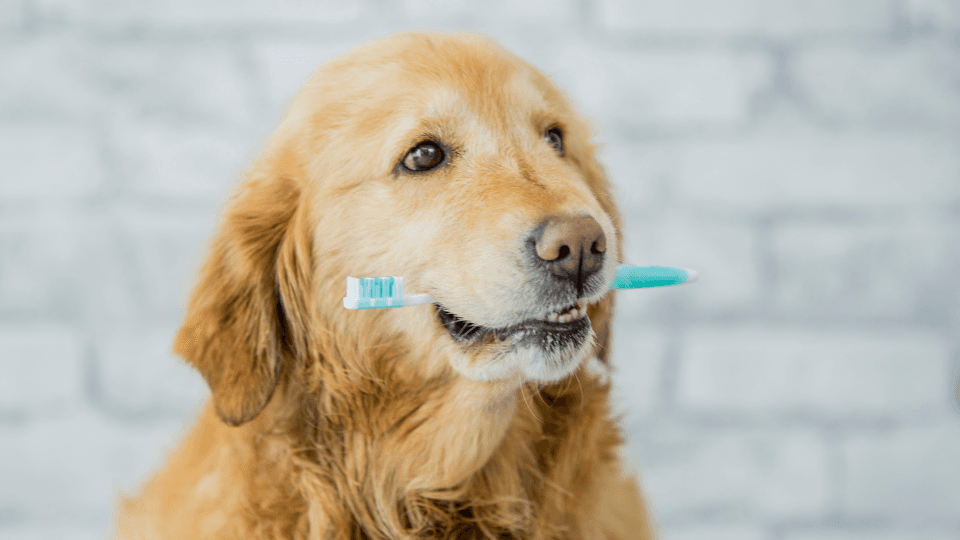
Budgeting For Pet Dental Costs: Vet Bills, Insurance & More
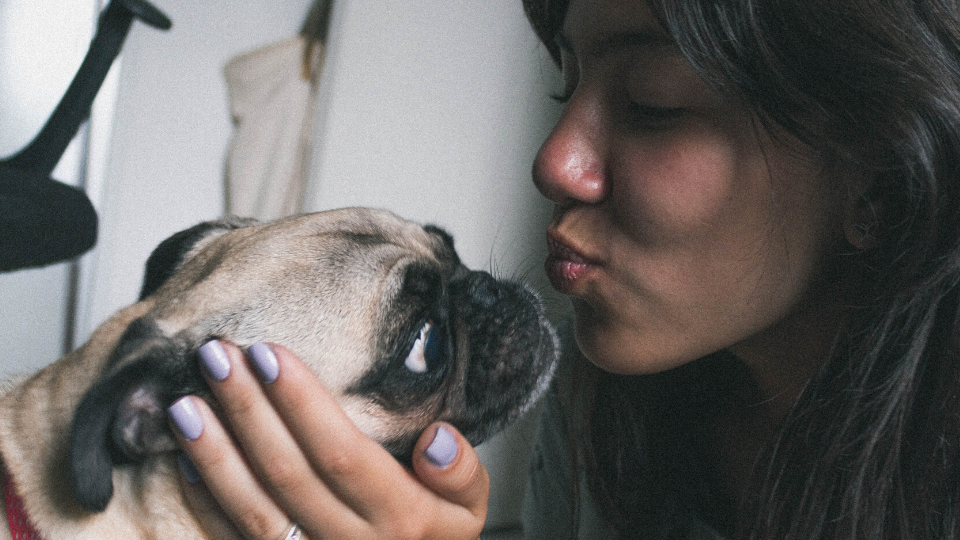
Average Pet Insurance Cost in 2022 by Breed, Age, & State

Dog Cataract Surgery Costs and How to Save
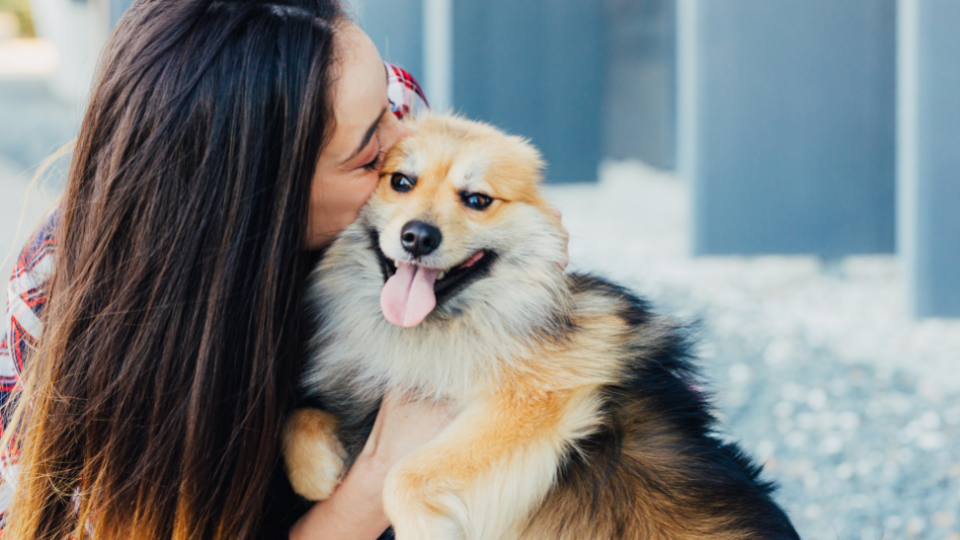
Dog Teeth Cleaning Costs: Best Ways To Save On Dental Care
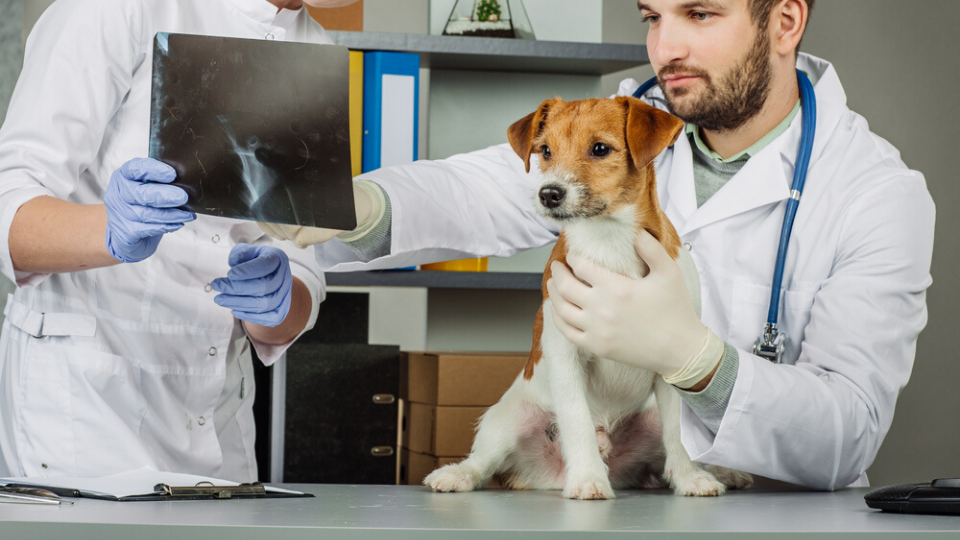
Dog X-ray Costs and How to Save
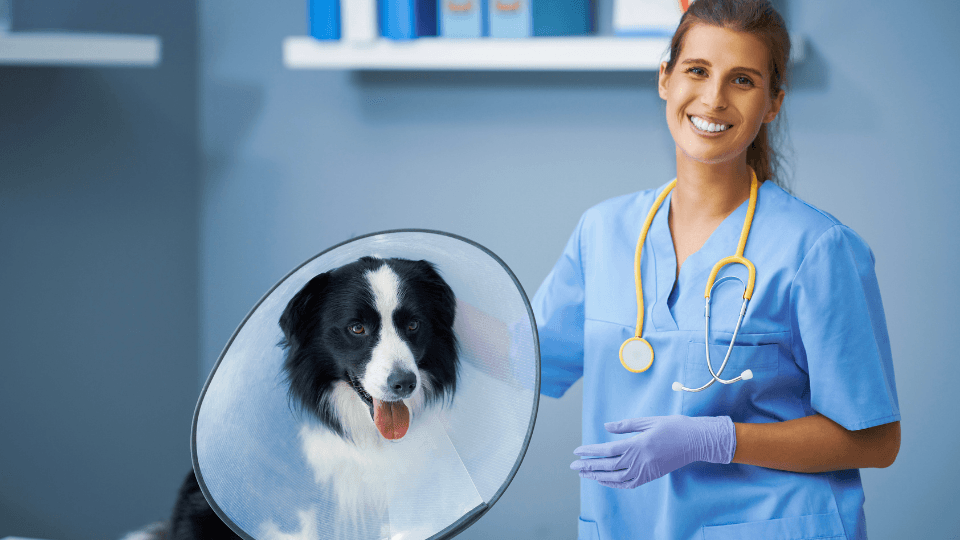
How Much Does it Cost to Spay or Neuter a Dog?
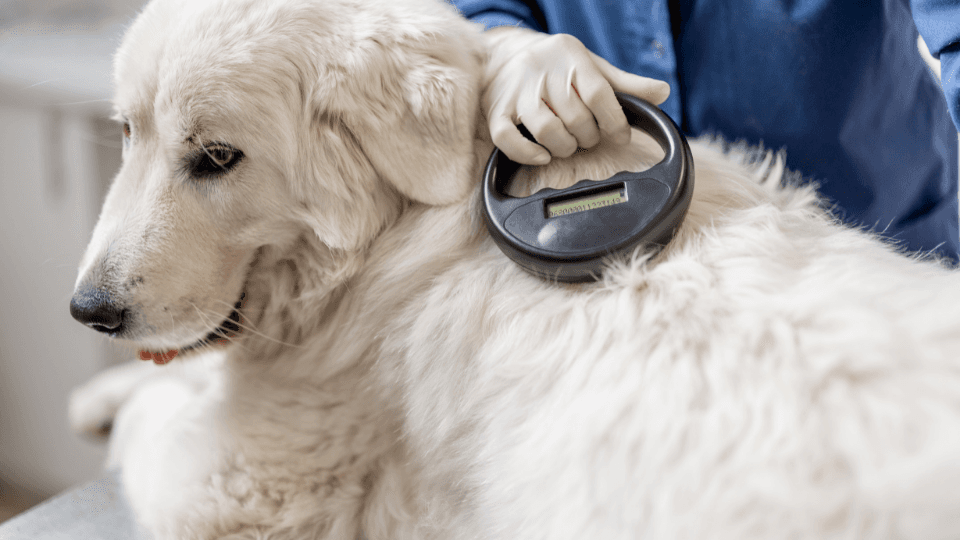
How Much Does It Cost to Microchip a Dog?
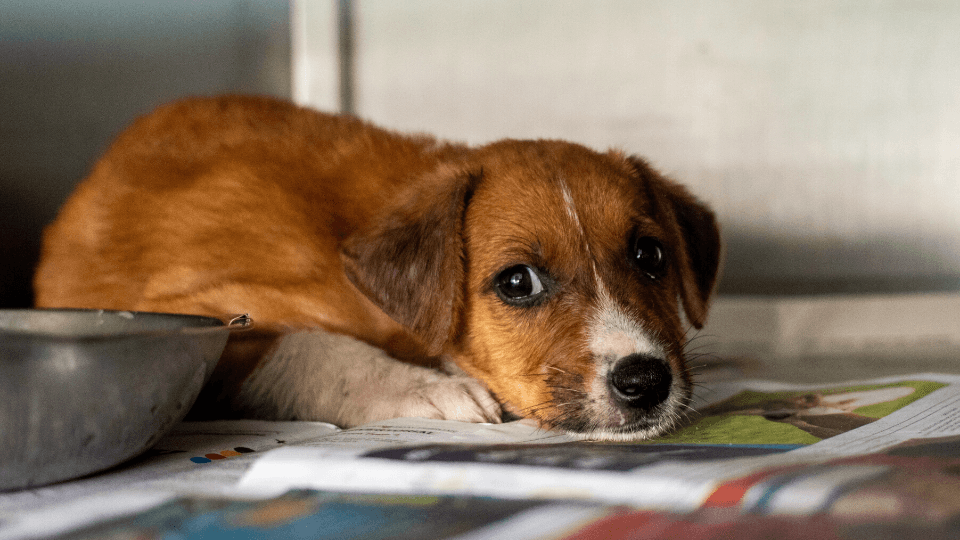
How Much Does It Cost to Treat Parvo?
More on pet insurance.

How To Compare Pet Insurance Plans
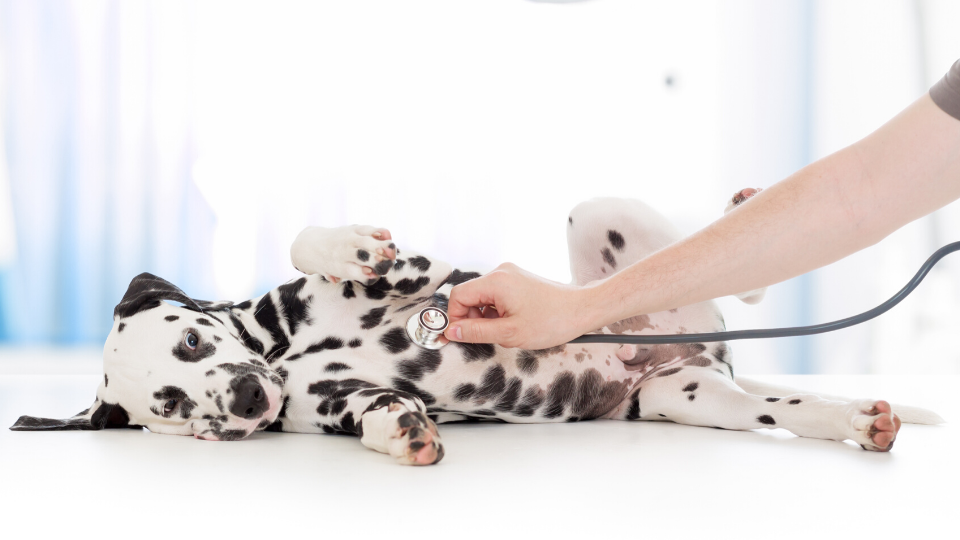
Is Pet Insurance Worth It? Here's A Vet's Perspective
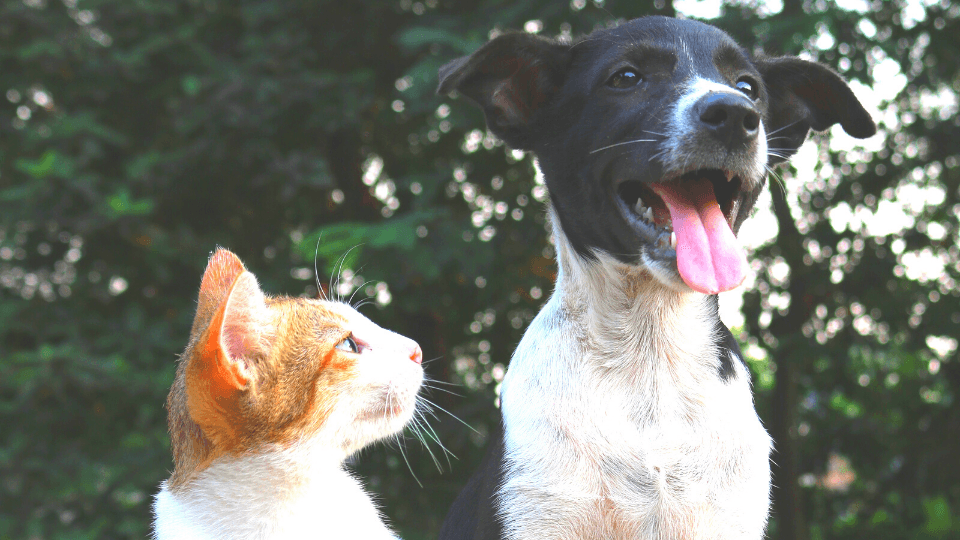
How to Get the Best Pet Insurance Plan, No Matter the Provider

How Soon Does Pet Insurance Take Effect?

Pet Insurance for More Than One Pet: Multi-Pet Discounts And Strategies

When Is Pet Insurance A Great Decision?

How Pet Insurance Works: Your Essential Guide

5 Reasons Why Outdoor Cats NEED Pet Insurance

Fascinating Pet Insurance Statistics 2019-2020


- For Consumers
- How It Works Prospective Cardholders Existing Cardholders
- Categories Animal/Pet Care Cosmetic Dentistry Vision More Healthcare Services
- Find a Location
- Resources FAQs Payment Calculator Pay a Doctor or Provider Well U Blog Testimonials & Reviews Financial Glossary
- For Providers
- How It Works
- Industries Healthcare & Wellness Health Systems & Hospitals Animal Healthcare
- Resources Insights Tools Partnerships FAQs
- Our Partners
- Back to Veterinary Financing
How Much Does a Vet Visit Cost?
Average veterinary pricing by procedure.
When your dog, cat, or other pet needs to see the vet, there are a variety of factors that can impact the total price of your final bill. Below, we'll explore some of the common reasons your pet may need to see a veterinarian, as well as the average costs for routine checkups or specialty treatments and procedures.
When to Take Your Pet to the Vet
Your pet may need to see a vet for many different reasons, and how much it costs depends on the type of vet visit. Common reasons to take a pet to the vet include:
- • Routine checkups : Routine veterinary exams are similar to human physicals. They're meant to help keep your pet healthy by assessing their overall wellness, treat any ongoing conditions, and follow up on any concerns you may have.
- • Vaccinations : You may have to set up a series of appointments to make sure your pet gets the properly scheduled vaccination shots to help prevent conditions like rabies and Bordetella.
- • Illness : Maybe your pet isn't drinking much water, or they're throwing up. You'll want to take them in for a sick visit, where your vet will check their baseline health and may recommend running some tests to figure out what's going on.
- • Emergencies : There may be a time that you're pet needs immediate medical attention, which means an emergency vet visit. Emergency visits can mean the difference between life and death, and you can expect that the cost of an emergency vet visit will be higher due to specialized equipment and treatments. 1
- • Surgical/Specialty visits : You may need to see a specialist to set up surgical procedures like spaying or neutering , dental extractions , fracture repairs, foreign object removal , or cancer -related surgery or chemotherapy treatment .
National Average Cost for a Vet Visit
The national average cost for a routine vet visit is between $25-$186. 2 During a routine veterinary appointment, your vet will perform a physical exam to assess your pet's health. The vet will likely check for:
- • Vitals : heart rate, breathing, temperature, weight
- • Signs of infection : ears, eyes, nose, mouth
- • Parasites : coat and skin
Average vet visit cost by state*
* To see all the states click here .
Routine Veterinary Exam Costs by Procedure
A routine veterinary exam is a good time to discuss any concerns you may have about your pet's health and to get preventive treatment for common health issues.
Dog and Cat Vaccine Pricing Info
On average, vaccinations for dogs and cats will cost between $20-$60, and can help protect them from catching serious diseases, like rabies. 4
Vaccination cost for dogs
Here are the average costs of some common vaccinations your dog may need:
Vaccination cost for cats
Here are the average costs of some common vaccinations your cat may need:
Veterinary Tests and Diagnostic Costs
You'll want to set up a special appointment with your vet if you think your pet is sick ( or worse ). For example, the following are symptoms your pet may exhibit which could require further evaluation, tests, and diagnosis from your veterinarian: 6
- • Increased thirst
- • Changes in appetite
- • Increased urination
- • Lethargy or tiredness
- • Panting
- • Coughing or sneezing
- • Weight gain or loss
- • Body odor
- • Breathing rate
- • Whining
- • Coat or skin changes
- • Behavior changes
If your pet is exhibiting signs of an illness, your vet will likely want to run some tests to help determine what's going on. They may require things like blood tests, X-rays, or fecal exams. 3
Once your vet has the results, they will provide a course of treatment to address the cause of your pet's symptoms and hopefully help your fur baby feel better.
Below is the average cost of diagnosing and treating some common health problems your pet may experience.
Emergency Vet Care Costs
An emergency veterinarian visit is an unscheduled trip to the vet to get help for your pet in an urgent or critical situation. There are many reasons you might need to take a pet to see an emergency veterinarian, such as: 8
- • Trauma : Bite wounds, electrical shock or being hit by a car
- • Toxins : When you know you're pet has consumed foods or chemicals that are poisonous, like antifreeze, human medications, chocolate, insecticides, certain plants and other toxic substances a visit to the emergency vet may be needed.
The price of an emergency vet visit will depend on the situation, but you can anticipate that it will be more expensive than a routine visit due to specialized care and testing. Below are the costs for initial assessment, stabilization, and treatment.
Surgery and Specialty Treatment Costs
If your pet has an underlying condition, or something is discovered as a result of testing during a wellness check, your vet may recommend specialized treatment. The cost of these treatments ranges widely depending on the type of care needed and the type of animal.
We've outlined some common treatments and average associated costs below:
Average Vet Visit Cost by State (Continued)
The information, opinions and recommendations expressed in the article are for informational purposes only. Information has been obtained from sources generally believed to be reliable. However, because of the possibility of human or mechanical error by our sources, or any other, Synchrony and any of its affiliates, including CareCredit, (collectively, “Synchrony") does not provide any warranty as to the accuracy, adequacy, or completeness of any information for its intended purpose or any results obtained from the use of such information. The data presented in the article was current as of the time of writing. Please consult with your individual advisors with respect to any information presented.
© 2023 Synchrony Bank.
1 Lee, Justine. “When to Bring Your Pet to the ER Vet,"Animal Emergency and Referral Center. Accessed January 20, 2023. Retrieved from: https://aercmn.com/when-to-bring-your-pet-to-the-er-vet/
2 Average Pet Wellness Check Study by State, Conducted by ASQ 360 ° on behalf of CareCredit, August 2023.
3 Plotts, Edwin. “How Much Does a Vet Visit Cost? Here's Everything You Need To Know," Pawlicy Advisor. Accessed January 20, 2023. Retrieved from: https://www.pawlicy.com/blog/vet-visit-cost
4 “Veterinary Services & Pricing," Access Veterinary Care. Accessed January 20, 2023. Retrieved from: https://www.myaccessvetcare.com/veterinary-services
5 Batiari, Lila. “Puppy Deworming Schedule: Everything You Need to Know," PawlicyAdvisor. Accessed January 20, 2023. Retrieved from: https://www.pawlicy.com/blog/puppy-deworming-schedule/
6 “How to tell if your cat is sick: Signs and Symptoms," Hillcrest. Accessed January 20, 2023. Retrieved from: https://www.hillcrestanimals.com/site/blog-memphis-vet/2020/03/12/how-to-tell-if-your-cat-is-sick
7 Drexler, Abby. “How to Tell if Your Dog is Sick: 11 Common Symptoms," American Kennel Club. January 24, 2022. Retrieved from: https://www.akcpetinsurance.com/blog/5-common-signs-that-your-dog-is-sick
8 Croll, Maxime. “Average Cost of Pet Insurance: 2022 Facts and Figures," Value Penguin. March 1, 2022. Retrieved from: https://www.valuepenguin.com/pet-insurance/average-cost-of-pet-insurance
10 “Pet Emergency Statistics and Veterinary Costs," Preventative Vet. Accessed January 20, 2023. Retrieved from: https://www.preventivevet.com/pet-emergency-statistics
11 2023 Average Procedural Cost Study for Cosmetic, Dental and Veterinary Practices across the United States. ASQ360° Market Research, October 2023
12 “Cutting Pet Care Costs," ASPCA. Accessed July 7, 2022. Retrieved from: https://www.aspca.org/pet-care/general-pet-care/cutting-pet-care-costs
Looking for pet costs not covered here?
Learn more about pet care and veterinary costs in Well U.
Have you used CareCredit to pay for your family's Veterinary care?

Tell us how you plan to use the card
Pet Wellness Exams: How to Prepare

You know the saying: An ounce of prevention is worth a pound of cure.
Even though it’s become a cliché, it’s true. Regular wellness checkups help catch problems early, when treatment is most likely to be successful. They also keep pets happy and healthy and can save a lot of money in vet bills in the long run.
How Often Should Cats and Dogs Go to the Vet?
The recommended frequency for wellness checkups depends on a pet’s age.
Puppies and Kittens
Puppies and kittens grow and develop incredibly fast! They generally need to see a veterinarian for wellness care every 3 to 4 weeks, starting when they are 6 to 8 weeks old and ending when they are between 16 and 20 weeks old. Then their next wellness exam is usually scheduled about one year after their last puppy or kitten visit.
Adult Dogs and Cats
Most adult pets in the prime of their lives do just fine with annual wellness exams.
Senior Dogs and Cats
Because pets age more rapidly than we do, it’s a good idea to start bringing your pet to see the veterinarian every 6 months once they hit their senior years. This transition occurs around 7 years of age for medium-sized dogs, a year or two earlier for large and giant breeds, and a bit later for cats and small dogs.
What to Expect at a Pet Wellness Checkup
There’s a lot to cover during a pet wellness checkup. At every visit, the veterinarian, technician, and other clinic staff will:
Measure your pet’s weight, temperature, pulse rate, and respiration rate. By doing this at least once a year, your veterinarian can get a feel for what’s normal for your pet and see what’s changing.
Ask questions about your pet’s diet, lifestyle, behavior, and health history. This is the time to bring up any concerns you might have.
Perform a full physical exam. The veterinarian will examine your pet from head to toe, looking for early signs of health problems. This will include an oral exam, listening to the heart and lungs with a stethoscope, examining the eyes with an ophthalmoscope, looking in the ears with an otoscope, body condition scoring (a way to monitor weight), feeling lymph nodes and organs within the abdomen, performing a rectal exam, checking reflexes, watching how your pet moves, assessing them for pain, and much more.
Next, the veterinarian will review your pet’s records to determine what diagnostic testing is needed, based on your pet’s age, lifestyle, and overall health:
Fecal exam – Most adult dogs and cats should have a fecal examination at least once a year to check for intestinal parasites. Young animals are especially susceptible to worms, and they benefit from fecal examinations at every puppy or kitten visit.
Heartworm test — Dogs and cats over 7 months of age should be tested for heartworms before starting prevention. The American Heartworm Society recommends annual testing for dogs even when they are on heartworm prevention so that any breakthrough infections can be caught early.
FeLV / FIV test – It is important to know whether a cat is infected with feline leukemia virus (FeLV) or feline immunodeficiency virus (FIV). According to the American Association of Feline Practitioners , the timing and frequency of testing should be based on a cat’s age, history, health, and lifestyle.
Bloodwork and urinalysis – When pets reach their senior years, it makes sense to run a panel of laboratory tests to screen for diseases that become more common in old age. Veterinarians commonly recommend a complete blood cell count, a blood chemistry panel, a urinalysis, and thyroid testing (for cats) at least once a year for their older patients.
Finally, the veterinarian will talk to you about what type of preventive care your pet needs:
Vaccines – At every wellness visit, the veterinarian will assess a pet’s need for new vaccinations and vaccine boosters (some can be given every 3 years). It may also be possible to check a pet’s vaccine titer to determine if boosting is necessary. Core vaccines are immunizations that virtually all pets should receive.
Core vaccines for dogs: rabies, distemper, adenovirus, parvovirus
Core vaccines for cats: feline viral rhinotracheitis, calicivirus, panleukopenia, rabies
The decision to give non-core vaccines like Bordetella, canine parainfluenza, canine influenza, Lyme, and leptospirosis (dogs) or feline leukemia virus (cats) is based on a pet’s age, health, and lifestyle.
Parasite prevention – Dogs and cats are at varying degrees of risk for fleas, ticks, heartworms, intestinal worms, and other parasites based on their age, where they live, and their way of life. Your veterinarian can put together an appropriate parasite prevention plan based on all these factors. Many products now treat multiple types of parasites with a single dose, given monthly or less frequently.
Pet ID – Combining visible forms of pet ID, like a collar tag along with a microchip, greatly increases the odds of being reunited with a lost pet. Once a pet has a microchip, you must keep your contact information current with the chip’s company. Inserting a microchip under the skin is a quick, relatively inexpensive procedure that your vet can do at any appointment.
Spay/neuter – Most pets who are not going to be a part of a breeding program should be spayed or neutered. Your veterinarian can discuss the benefits, risks, and appropriate timing of spaying and neutering.
Dental care – Good dental care is essential to pet well-being. Your veterinarian can tell you if your dog or cat needs a professional dental cleaning and recommend appropriate dental home care.
Grooming – Regular brushing, bathing, nail trims, haircuts, and ear cleanings may be needed to keep your pet looking and feeling their best. Your veterinarian can help you determine what grooming your pet needs.
Daily life, behavior, diet, and exercise – Your veterinarian will give advice about behavior, diet, exercise, environmental enrichment, litter box management, diseases that can be passed between pets and people, and disaster preparedness.
How Much Does a Vet Checkup Cost?
Below are some typical costs associated with routine wellness care for dogs and cats:
Office visit/physical examination: $40 - 90
Panel of screening bloodwork: $50 - 200
Urinalysis: $20 - 60
Fecal examination: $25 - 50
Core vaccines (each): $20 - 45
Microchip placement: $20 - 75
Heartworm test: $20 - 50
FeLV/FIV test: $20 - 40
Nail trim: $10 - 20
Veterinary offices should be able to provide you with a detailed estimate for your pet’s expected wellness care. Don’t be embarrassed to ask for an estimate before you schedule an appointment.
The cost of pet checkups can vary quite a bit, based on several factors, including the age of your pet, where you live, and the type of clinic.
Your Pet’s Health and Age
For example, a wellness visit for a healthy 2-year-old Shih Tzu who doesn’t need any vaccine boosters is going to be relatively cheap. On the other hand, a wellness checkup for a 15-year-old Siamese cat who routinely goes outdoors could include multiple vaccine boosters and a lot of lab work, and those costs add up.
Location also plays a big part in determining the cost of veterinary care. The 2019 Nationwide/Purdue Veterinary Price Index shows that the highest average weighted price for veterinary services ($406 in San Francisco) was 1.5 times higher than the lowest average weighted price ($265) for rural areas far from large cities.
Type of Clinic
Finally, the type of clinic you go to affects what you will pay. Some not-for-profit organizations provide basic care, like rabies vaccines, at cost. Vaccine clinics also tend to be inexpensive, but you may not be able to access all the care your pet needs.
Getting pet wellness care through a full-service veterinary hospital may not be the cheapest option, but it does provide one-stop-shopping and lets you build a relationship with the doctors and technicians you’ll be relying on if your pet is injured or becomes sick.
How to Prepare for Your Pet’s Wellness Exam
Being prepared will make your pet’s wellness exam go more smoothly, be less stressful, and even save you money. Here are some steps to take to prepare:
If your pet has received veterinary care elsewhere, bring their health records with you or have them forwarded to your current clinic. This will help prevent unnecessary duplication of diagnostic tests or preventive care.
Take pictures or make a list of all the medications, supplements, and foods (including treats) you give your pet.
If possible, bring a fresh stool sample from your pet with you, but don’t worry if that’s not possible. Your veterinarian will probably be able to collect a sample from your pet if necessary.
Write down any questions you have about your pet’s wellness care. Your veterinarian will be happy to talk anything over, but you have to ask!
Featured Image: iStock.com/PeopleImages

Veterinarian
Dr. Jennifer Coates is an accomplished veterinarian, writer, editor, and consultant with years of experience in the fields of veterinary...
Help us make PetMD better
Was this article helpful?
Related Articles

Subscribe to Our Newsletter
Sign up for weekly pet health tips and insights from our veterinarians.
Hepper is reader-supported. When you buy via links on our site, we may earn an affiliate commission at no cost to you. Learn more .
How Much Does a Vet Visit Cost for a Cat? 2024 Price Update

By Nicole Cosgrove
Updated on Feb 27, 2024
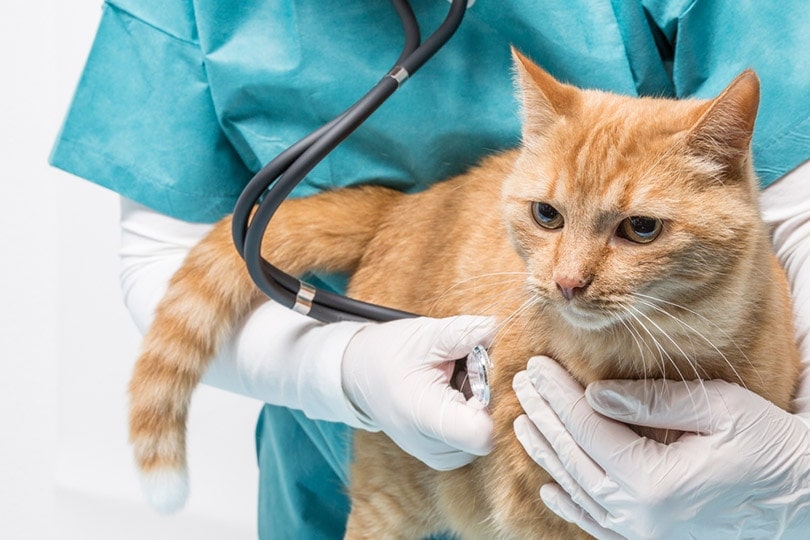
Vet approved
Reviewed & Fact-Checked By
Dr. Tabitha Henson
DVM (Veterinarian)
The information is current and up-to-date in accordance with the latest veterinarian research.
Even though vet visits can be expensive, routine vet visits are a must for any cat. Even if your cat seems healthy, you need to take it to the vet at least once a year to ensure your cat is in peak condition.
The good news is that vet visits probably aren’t as expensive as you might think, and pet insurance can help you out. A physical exam will cost between $45–$55 for a cat. Scroll down to learn in detail how much it costs to take your cat to the vet.
The Importance of Regular Vet Visits
Regular vet visits will help your cat live a long and happy life. The vet visit will be sure that your cat is aging healthily and is of healthy weight. It will also help to catch any diseases early on so that your cat has the best chances of recovery.
As your cat gets older, regular visits become even more important. With age, cats will start developing more illnesses and diseases.
More so, taking your cat to the vet regularly will make it easier to diagnose your cat if something is wrong. After all, it can be difficult to know if a cat is sick if they’ve never been examined before. Routine examination just ensures that your cat is being looked at by a professional to prevent and catch any diseases as early as possible.
How Much Do Vet Visits Cost?
Whenever you go to the vet, there are many factors to consider when determining the cost. A physical exam will cost between $45–$55 for a cat. If your cat needs medication or vaccines , most shots cost an additional $15–$28. For most people, a single trip to the vet will end up costing between $90–$200 for cats, which is nearly half that of a dog.
Keep in mind that these prices are for routine, annual vet visits. If your cat becomes sick or gets injured with unanticipated ailments, the visit may cost a lot more in order for the cat to get the treatment and medication it needs.
For example, emergency treatments can quickly increase to over $1,000, especially if hospitalization is necessary. Emergency treatments are expensive because the cat needs to be seen, diagnosed, and treated, which starts racking up the price dramatically.
Something else to consider is your cat’s age. Young, healthy cats will likely only need to go to the vet once a year, and they won’t need much treatment either. Older cats, however, will need more preventative measures and medications, as well as more frequent vet visits.
As a result, taking your geriatric cat to the vet is normally twice as expensive, if not more, than taking your young cat to the vet.
Additional Costs to Anticipate
There are certain costs you can anticipate when taking your cat to the vet. First, the vet will do an exam of your cat, which involves evaluating its ears, eyes, mouth, skin, heart and lungs, abdomen, muscles, joints, and bones. This exam is called the physical exam. This is the base price for the visit.
From there, the vet may decide to do routine testing that requires different tools and resources. Depending on your cat’s needs or age, the vet may call for blood work, a heartworm test, a urinalysis, or a fecal examination. Each one of these tests will increase the cost.
If your cat is in an emergency situation, the cat may need to be X-rayed as well. This is not a normal cost to anticipate, but it may be needed if your cat is limping or finds itself in an emergency situation.
Here’s a look at some standard prices for different services:
How Often Should I Take My Cat to the Vet?
Whenever your cat is young and healthy, you should take it to the vet at least once a year, though twice a year would be more ideal. This ensures that your cat is up to date on all its needed vaccines and medications. As your cat gets older, it’s a good idea to begin taking it to the vet twice a year for biannual checkups.
Of course, take your cat to the vet anytime it is sick or acting strange. These vet visits will be sporadic and only as needed, but they will make a huge difference in the happiness of your cat.
Does Pet Insurance Cover Vet Visits?
If you cannot afford to pay for your cat’s vet visits, you might want to consider investing in a pet insurance policy that includes wellness. Wellness plans will normally cover routine veterinary visits, including exams and other preventative care.
Of course, not all pet insurance will cover vet visits. It ultimately depends on your insurance plan . So, it’s critical to thoroughly read your pet insurance coverage to find out if it covers vet visits. In many cases, it does.
That being said, most pet insurance is reimbursement-based. In other words, you will pay for the vet visit upfront, but the insurance plan will reimburse you.
If you are looking for a pet insurance plan that offers great value, Spot's customized plans can be adjusted to suit your pet and your budget. You may be able to cover your pet at a cost that suits you.
What to Do for Your Cat’s Health Between Vet Visits
Between visits, it’s important to pay attention to your cat and monitor its behavior so that it remains healthy and happy. That way, you will know when you should take your cat to the veterinarian if it is acting strangely.
For example, select a high-quality cat food diet and feed your cat water and food on a consistent schedule. If the cat stops eating, you know that’s a sign something is wrong. More so, try to play with your cat as frequently as possible so you can monitor its weight and health. Depending on the coat type, you will also need to brush the coat routinely.
Don’t forget about your cat’s teeth. Most people fail to brush their cat’s teeth, which results in pricey dental bills down the road. Brushing your cat’s teeth weekly will help to prevent extensive dental care in the future.
If you notice your cat is acting strangely, call the vet and set up an appointment immediately. Even if it’s not time for your routine visit yet, seeing the vet will make sure your cat is healthy and happy.
On average, cat owners spend between $90–$200 on the cat’s routine vet visits. These visits include physical exams, vaccines, routine blood work , and preventative measures. As the cat gets older , you can expect the price tag to go up as your cat will need more care.
At the very minimum, take your cat to the vet once a year for a routine checkup. If you can’t afford your cat’s checkups, consider investing in cat insurance so that you can get reimbursed for the vet bills.
- See also: When Is National Take Your Cat to the Vet Day?
Featured Image Credit: bmf-foto.de, Shutterstock
Related Articles
Further Reading
Can Cats Sense Tsunamis Before They Happen? Facts & FAQ
Mar 14, 2024 - 5 min read
Hypertension in Cats: Signs, Causes & Care (Vet Answer)
By Dr. Sharon
Jan 23, 2024 - 6 min read
Why Is My Cat Panting After Playing? 5 Vet-Reviewed Reasons
Feb 8, 2024 - 4 min read
Vet Articles
Latest Vet Answers
The latest veterinarians' answers to questions from our database
How Should I Introduce My Puppy to a Dominant Dog?
Answered by Dr. Joanna Woodnutt, BVM BVS (Vet)
Betta Fish Gill Flukes: Causes, Signs, Treatment & Prevention
Answered by Dr. Luqman Javed, DVM (Vet)
How to Help an Abused Dog Recover: 8 Tips & Tricks
Answered by Dr. Sharon Butzke, DVM (Vet)
Dog Ear Hair Plucking: Our Vet Answers Concerns & Alternatives
Answered by Dr. Karyn Kanowski, BVSc MRCVS (Vet)
How to Check a Dog’s Heart Rate: Our Vet’s Tips, Tricks, & Guide
How to Cycle Your Aquarium Using Liquid Ammonia – Our Vet Explains
Cat food recalls
Have a cat? Stay on top of cat food recalls here >
Dog food recalls
Have a dog? Stay on top of dog food recalls here >
Have a question? talk to a vet online for advice >

When you use our links to buy products, we may earn a fee but that in no way affects our editorial independence.
How Much Does a Vet Visit Cost?
Table of Contents
What Factors Impact the Cost of a Vet Visit?
How much does a routine vet visit cost, how much does an emergency vet visit cost, key takeaways.
- The cost of a vet visit can vary widely depending on the reason. In general, routine checkups will cost less than something like a visit to the emergency vet.
- Pet insurance can help cover many vet-visit costs, though most base plans are typically limited to events like accidents and illnesses.
Visits to the vet can be expensive. It’s important to understand the things that can impact costs and the tools, like pet insurance, that can help. While pet insurance plans generally assist with unexpected costs, like illnesses and injuries, wellness add-ons can help with routine and preventive care. Here’s a breakdown of what you need to know about the cost of vet visits.
There are several factors that can help determine how much you end up paying for a vet visit, including:
- Pet type: Some procedures may cost more for a dog versus a cat, for example.
- Pet gender: Certain procedures can also cost more or less depending on whether your pet is a male or a female. (for instance, sterilization surgeries.)
- Your pet’s health history: Some procedures may cost more for animals based on their health history since that could complicate things.
- Reason for the visit: A routine check-up is probably going to cost less than one that requires extensive testing or an especially costly procedure, like surgery.
- Where you take your pet: Some vet offices or other facilities may provide cheaper care than others.
The cost of a routine vet visit can vary pretty widely. For example, if you have a pet cat, basic vaccinations could run you $80 to $160. But dog vaccinations (which may include rabies; DAPP/DHPP (distemper, adenovirus/hepatitis, parainfluenza, parvovirus); lyme disease; leptospirosis; and canine influenza, among others) can cost up to $300 if done in the same visit. Or, for a wellness visit, where the vet will check things like bloodwork and perform a dental check, the costs could be anywhere from $45 to $300, depending on the type of pet you have and where you go for care.
Some other vet visits, like spay or neuter surgery, could range in cost from hundreds of dollars to upwards of $1,000, depending on the type of animal and the level of care chosen, which may include IV medication and pre-surgery blood work. And that’s assuming you don’t add on additional services, such as microchipping or vaccinations. But also keep in mind that depending on where you live – and other factors, such as income – there could be low-cost or even no-cost spay and neuter programs available. One good way to explore these possibilities is to contact an area humane society.
And routine vet visit costs can often be covered by pet insurance wellness plans. What’s covered – and how much coverage is available – depends on the wellness plan you select, though.
There are many reasons why a pet may need an emergency vet visit, from swallowed objects, to ingesting toxins or breaking a bone. Some of these causes will require more testing, and therefore more cost, than others. And while some veterinary clinics will offer both emergency and general care, you may have to go to an emergency 24-hour clinic instead, which could have different rates than your usual vet. Plus, the longer your pet needs care, the more it may cost, particularly if they need to stay and be monitored overnight.
Here are some common costs you may encounter during an emergency vet visit for a dog, along with possible price ranges:
- X-ray: $150 to $250
- Wound treatment: $800 to $2,500
- Short-term hospitalization (1 to 2 days): $600 to $1,700
- Emergency surgery: $1,800 to $5,000
- Oxygen therapy: $800 to $3,000
And here are some costs you may encounter when seeking emergency services for a cat:
- Wound treatment: $800 to $1,500
- Short-term hospitalization (1 to 2 days): $600 to $1,500
- Emergency surgery: $1,500 to $3,000
- Oxygen therapy: $500 to $2,500
There could also be an exam fee, which allows the vet to assess whether any testing needs to be done to help your pet, as well as diagnostic testing if necessary.
How Much Does a Diagnostic Vet Visit Cost?
Sometimes your pet has health issues that aren’t an immediate threat to their wellbeing, but that may require treatment, such as a change in their diet or medications. In that case, you may be going to the vet for diagnostic testing. The costs can vary quite widely, as diagnostic care can include everything from X-rays and urine tests to more expensive procedures like an MRI. This doesn’t include the upfront costs that may lead to the need for diagnostic testing, such as routine blood work.
Here are some costs you may encounter for a diagnostic vet visit for a dog or cat:
- X-ray: Up to $250
- Fecal exam: $25 to $60
- Ultrasound: $300 to $600
- Lab tests: $200 to $300
- Urine tests: $25 to $100
- MRI: $1,500 to $2,500
Keep in mind that some tests, like X-rays, may have more complex and expensive versions, so that can impact your total costs. And if there are multiple areas of the body affected, that may mean paying more. Diagnostic testing costs can be hard to predict, which is why you can (and should) ask for a quote up front. That way, you’ll be better prepared and can understand your options.
Remember that the cost of vet care, whether routine, emergency, diagnostic, or other, can vary based on many factors, including where you live. The numbers listed here are provided only as examples. The surest way to estimate the cost of a particular treatment or procedure is to ask a local pet healthcare professional.
Does Pet Insurance Cover Vet Visits?
The purpose of pet insurance is to cover unexpected medical events, so some vet visits will certainly be covered. Typically, a basic pet insurance plan will not cover routine or preventive care – that’s where a wellness plan add-on may come in handy.
Vet costs resulting from accidents and covered illnesses that happen after the policy’s waiting period, however, will be covered. This can include things like the X-rays or blood work needed to diagnose a broken bone or illness, hospitalization costs, wound treatment, and emergency surgery.
Keep in mind, however, that pet insurance plans have exclusions, so be sure to familiarize yourself with those before purchasing a policy. Exclusions can vary by insurer.
Many pet insurance companies offer wellness plans as an add-on that can cover routine and preventive care at an additional cost. That can include things like flea, tick, and heartworm medications, routine vaccinations, and the cost of seeing a vet for your pet’s regular checkup.
In most cases, a pet insurance policy will help cover costs related to illnesses and accidents, but it won’t cover preexisting conditions or routine or preventive care. However, insurers may provide the option to get routine and preventive costs covered with a wellness add-on. Otherwise, that would have to be paid out-of-pocket or via a specific wellness plan.
For covered costs, you would typically pay for the treatment or procedure yourself and then be reimbursed by the insurer up to a certain percentage once you’ve hit your plan deductible. So there is a bit of a delay in the payment.
Let’s say you have a $500 vet bill that’s covered by your pet policy, with a 90% reimbursement rate. Assuming you’ve met the deductible for the year, you’d get $450 back for that charge. Often, the higher the reimbursement rate, the higher the monthly premium, so that’s something to consider when shopping for a policy.
For more information about pet insurance, see the following guides:
- Best Pet Insurance Companies
- Best Cheap Pet Insurance Companies
- How Much Does Pet Insurance Cost?
- ASPCA Pet Health Insurance
- Healthy Paws
- Progressive
Best Pet Insurance by State
- Best Pet Insurance in Arizona
- Best Pet Insurance in California
- Best Pet Insurance in Colorado
- Best Pet Insurance in Connecticut
- Best Pet Insurance in Florida
- Best Pet Insurance in Indiana
- Best Pet Insurance in Massachusetts
- Best Pet Insurance in Michigan
- Best Pet Insurance in Minnesota
- Best Pet Insurance in New Jersey
- Best Pet Insurance in New York
- Best Pet Insurance in North Carolina
- Best Pet Insurance in Ohio
- Best Pet Insurance in Oregon
- Best Pet Insurance in Pennsylvania
- Best Pet Insurance in Texas
- Best Pet Insurance in Utah
- Best Pet Insurance in Virginia
- Best Pet Insurance in Washington
- Best Pet Insurance in Wisconsin
Related 360 Reviews
- Best Homeowners Insurance Companies
- Cheapest Homeowners Insurance Companies
- Best Renters Insurance Companies
- Cheapest Renters Insurance Companies
- Best Life Insurance Companies
- Cheapest Life Insurance Companies
- Best Car Insurance Companies
- Cheapest Car Insurance Companies
- Best Home and Auto Insurance Bundles
Why You Can Trust Us
At U.S. News & World Report, we rank the Best Hospitals, Best Colleges, and Best Cars to guide readers through some of life’s most complicated decisions. Our 360 Reviews team draws on this same unbiased approach to rate insurance companies and agencies. The team doesn't keep samples, gifts, or loans of products or services we review. In addition, we maintain a separate business team that has no influence over our methodology or recommendations.
- Countertops
- Curb Appeal
- Dining Rooms
- Entryways & Mudrooms
- Foundations
- Heating & Cooling
- Home Finances
- Home Offices
- Home Safety
- Inspections
- Kids' Rooms
- Landscaping
- Laundry Rooms
- Living Rooms
- Molding & Trim
- Natural Disasters
- Pathways & Sidewalks
- Pest Control
- Smart Homes
- Solar & Alternative Energy
- Storage & Organization
- Woodworking
- This Old House
- Ask This Old House
- New Yankee Workshop
- Project Houses
- Idea Houses
- Live Channel
- TV Listings
- Ways to Watch
- Best Gutter Guards
- Best Home Warranty
- Best Lawn Care
- Home Services Near Me
- Best Moving Companies
- Best Solar Companies
- Newsletters
- Makers Channel
What Is the Typical Cost of a Vet Visit?
What should you expect at a vet visit, annual checkup, diagnostic testing, ear or eye issues, emergencies, spaying or neutering, vaccinations, does pet insurance cover vet visits, is the cost of vet visit worth it, faqs about vet visit costs, how much does a vet visit cost (2024 guide).
Written by Brenda Woods Updated 04/03/2024
Brenda Woods is an accomplished writer and managing editor with more than two decades of publishing experience. She has spent over 10 years covering home services and home improvement projects. Brenda supports her team in evaluating dozens of home service providers, surveying and speaking to hom…
Pets need health care, and not just when they’re sick. Regular vet visits are essential to keeping your pet healthy and should be factored into your budget just like food and toys. How regularly you need to take your pet to the vet depends on its age, breed, and health, but most vets recommend at least once per year.
So how much will vet visits cost you? It depends on the reason for the visit. We looked at common vet bills from some of the best pet insurance companies to see how much different types of vet visits typically cost. See what you can expect to pay below.

The average cost of a vet visit is $50–$200, but certain tests and treatments will increase the price. It also depends on the level of care you choose, such as whether you opt to have anesthesia administered for procedures or take your pet to multiple specialists. A basic vet visit involving a brief, noninvasive assessment of your pet will cost closer to $50. A more thorough evaluation will cost more.
A vet visit is any instance in which you take your pet in to see a veterinarian. This could be for routine reasons or more dire circumstances, but there are some things most vets will do at almost every appointment:
- Administer flea, tick, heartworm, and other parasite prevention if needed
- Assess weight
- Check lymph nodes and throat
- Evaluate teeth
- Examine the eyes for redness
- Listen to the heart and lungs
- Look into the ears and nose for abnormalities
- Palpate the abdomen to check for masses or pain
- Take pulse and temperature
This evaluation will give your vet a good indication of your pet’s physical health. You’ll likely be asked questions about your pet’s behavior and have the chance to ask your own questions and share concerns. If you’ve come to the vet for a specific issue, your vet will make evaluations and administer treatment based on that condition.
What Are Reasons for Going to the Vet?
There are many reasons to take your pet to see a veterinarian. Here are some of the most common.
Vets recommend a yearly exam—twice yearly for senior pets—to make sure your pet’s health is on track and administer any preventive care your pet may need. A full physical can run anywhere from $100–$300 for dogs and $90–$200 for cats, depending on its age, breed, and location. The more testing your pet requires, the higher the price will be.
Pets experience allergies, too. Coughing, excessive licking, scratching, and sneezing are all signs your pet is dealing with allergies. A vet will likely conduct a skin test to determine what kind of allergy your pet has and make a treatment plan. This type of visit will likely cost $200–$250, or $200–$300 if a blood test is needed.
Diagnostic testing is necessary when you don’t know what’s going on with your pet. This can include blood work, MRIs, ultrasounds, urine tests, and X-rays. You should ask your vet in advance how much these tests will cost, but here are the average ranges:
- Blood work: $200–$300
- MRI: $1,500–$2,500
- Ultrasound: $300–$600
- Urine test: $25–$100
- X-ray: $75–$400, depending on the complexity
Eye and ear infections are common in pets. It could be due to bacteria, mites, yeast, or an unnoticed injury. A vet will examine the area, determine the cause, and recommend treatment, which may include a prescription. As long as the issue doesn’t point to a more serious health condition, this visit will typically cost $120–$150.
An emergency is the worst reason to have to see a vet. Thankfully, there are 24/7 emergency vet clinics and animal hospitals you can take your pet to if it experiences a serious injury or shows signs of illness. Just like with humans, going to an emergency clinic costs more. Here are the most common expenses:
- ER exam: $75–$200
- Overnight hospitalization: $600–$1,700
- Multi-night hospitalization: $1,500–$3,500
Spaying and neutering costs vary depending on the kind of veterinary care you want for your pet. Anesthesia, IV fluids, pain medication, and other add-ons will increase the price. Spaying also costs more than neutering because the procedure is more complex. Standard clinics charge $200–$400 for dogs and $50–$4,200 for cats.
Vaccinations are an important part of your pet’s health care. Core vaccinations should be administered in your pet’s first year of life based on the schedule your vet outlines. Your pet may need boosters as it ages.
Here are common vaccines and their costs:
- Bordetella: $19–$50/dose
- DAPP or DHPP: $25–$50/dose
- Feline leukemia: $25–$50/dose
- FVRCP: $25–$50/dose
- Influenza: $30–$50/dose
- Leptospirosis: $30–$50/dose
- Lyme disease : $30–$50/dose
- Rabies: $15–$50/dose
What Factors Affect the Cost of Vet Visits?
How much vet visits cost can vary depending on a few factors. Here are some of the most common.
Pet insurance can greatly offset veterinary costs and will cover most visits. Though routine checkups are rarely covered in basic accident-and-illness plans, diagnostic testing, emergency care, hospitalization, prescription medications, surgeries, and more are. Many providers offer wellness plans to cover preventive pet care, such as annual visits, for an extra monthly fee.
If you have a pet insurance plan, you’ll pay for your pet’s vet visit at checkout, then file a claim for that amount and get reimbursed by your provider within a couple of weeks. Most providers reimburse at least 70% of the vet bill, and some will reimburse as much as 100%.
We recommend pet insurance providers such as Lemonade , Spot , and Healthy Paws for their coverage and customer service.

If your pet needs care, the most important thing is to get to a vet as soon as possible. Being faced with a bill of $300 or more can be daunting, but visiting a vet clinic in a less metropolitan area can reduce the cost. We recommend that pet parents enroll their pet in a health insurance plan to prevent paying for vet bills out of pocket.
See our list of cheapest pet insurance companies for affordable options.
How much do most vet visits cost?
Routine vet visits typically cost $50–$300, depending on the evaluations and treatments performed. Emergency vet visits can run as high as a few thousand dollars.
Why does the vet charge so much?
Vet prices are high for various reasons. Vets set their rates based on their medical education and credentials, how complex the exam or procedure they’re performing is, your location, the use of expensive equipment, and other variables that warrant or require high fees.
How often should a dog go to the vet?
Healthy adult dogs should see a vet once per year for a routine wellness exam. Senior dogs should see a vet twice per year.
What are the most common vet visits?
Pet owners most commonly take their pets to the vet for routine care such as annual checkups, dental cleaning, vaccinations, and other preventive care. Other common reasons to take your pet to the vet are allergy testing, ear or eye infections, or illness or injury.

Didn't find what you need? Use the search!
Pet Keen is reader-supported. When you buy via links on our site, we may earn an affiliate commission at no cost to you. Learn more .
Vet Visits for Cats: How Much Will it Cost? 2024 Price Guide
Taking your cat to the vet for regular treatment and care is essential to the well-being of your pet. The primary variables we consider as consumers are how often and how much will it cost? But it’s important to remember that not all vet visits will be the same . The general rule for regular checkups is 1-2 per year. If your furry friend has other health issues, you may be at the vet much more frequently.
Unfortunately, and all too often, we pack our beloved felines into the travel carrier for a trip to the vet, which we all hate—let’s face it—and we don’t have any idea how much it’s going to cost.
We all love our cats, but regular checkups at the vet can lead to a high cost over the lifetime of your pet. If you have never had a cat before, it can be helpful to get an idea of the basic costs so you can be prepared. Keep reading as we break down the scenarios of the most common reasons for vet visits and give you an idea of how much each will cost. Some of these reasons include:
- Regular checkups
- Vaccinations
- Neuter or spay
- Deworming/flea treatment
Of course, prices for veterinary services may vary from city to city, state to state, and region to region. So, we’ve split the country up into east, west, and central United States, so the numbers will be a little more accurate.
How Much Does It Cost to Take My Cat to the Vet?
The cost of your vet visits will depend heavily on what type of visit it is and where you live. The eastern and western United States are much more densely populated than the center so you can expect to pay more in these areas, and the west will be slightly more than the east. However, the higher population and increased costs also mean a better chance your doctor will have better equipment and more experience. In the central states, especially where the population is more sparse, you will often save a few dollars.
- What Can I Expect When I Get to The Vet?
You will need to keep your cat in a carrier at all times when in the clinic because other animals can increase your pet’s stress level and may even chase them. You will need to sign in when you arrive and usually need to spend a few minutes in a small waiting area like you do at a regular doctor visit. After a short time, the vet will call you into the back and usually begins the examination by weighing the cat while still in the carrier. The vet will then remove the cat from the carrier and weigh the carrier again to get the correct weight of the cat.
Once your vet has the cat’s weight, they will continue the examination by checking the ears for signs of infection and parasites. Ear mites will look like a clump of black dirt or coffee grounds. The doctor will also need to check the eyes and mouth and ensure adequate flexibility in its limbs and joints, and they will also push on the stomach to feel for any lumps or signs of pain. If your cat is still a kitten, your vet may give vaccination shots. Following your appointment, you might need to schedule more appointments for additional vaccinations or routine checkups. It’s also a good idea to purchase your flea and tick medication, which also helps protect them from heartworm, even if it is an indoor cat.
The following chart will explain how much it might cost for different procedures in different parts of the country.
- Standard Vet Procedures by US Regions
Source: https://www.banfield.com/Services/price-estimator
- Additional Costs
The chart above gives you the most common expenses, but you may end up with additional costs as well. Some may be elective, and others will only occur once. Here are a few examples of some extra procedures that some cats may require.
- Tooth Extraction: $50 to $130
- Geriatric Screening: $200 to $250
- Blood Tests for Allergies in addition to Standard Bloodwork: $300 to $400
- Fecal Exam: $25 to $40
- Heartworm: $50 to $150/year
- What Does an Emergency Vet Visit Cost?
Some cats are accident-prone, so it will be no surprise if they have an emergency that requires immediate medical attention . If it’s during business hours, you shouldn’t need to pay much extra for a visit unless the doctor is extremely busy. However, you will likely incur some additional expenses depending on the emergency.
- X-rays can cost between $150 and $250. You will usually need X-rays if your cat swallows a sewing needle or other foreign object. Vomiting, diarrhea, and seizures might also cause your vet to call for an X-ray.
- Ultrasounds are a little more expensive and can cost as much as $300–$600. Ultrasounds are often elective, and you might choose to get one if your cat is pregnant to see how many kittens you will have.
- Your veterinarian might recommend a hospital stay of 1–2 days if your cat suffers from severe diarrhea or vomiting. If your cat recently began having seizures , your vet might recommend a short hospital stay for observation. You can expect to pay $600 to $1,500 for a short stay.
- If your cat has a more serious problem, like fecal impaction, kidney failure, or another serious issue, your vet might recommend a longer stay of 3–5 days. These longer observation times usually start at around $1,500 and can get as high as $3,000 depending on the required care level.
- If your cat gets a wound in a fight that requires cleaning and stitching, you can expect to pay $800–$1,500 for the emergency visit, numbing, stitching, and medication, depending on the extent of the injury.
- If your cat requires emergency surgery because of an injury caused by a motor vehicle, you can expect to pay at least $1,500 up to $3,000. The extent of the damages will greatly influence the cost, and you may have additional fees after the operation to get your cat back to good health.
- If your pet is having difficulty breathing due to asthma or heart failure and requires oxygen, you can expect to pay between $500 and $2,500 for the service, depending on how many treatments it requires.
- Can Pet Insurance Help Me Pay for Vet Bills?
Pet insurance can be a great way to protect yourself against high medical bills that can occur unexpectedly during the life of your cat, but many people ignore this option. It will usually cost between $25–$35 per month to keep your cat covered. It can seem like a lot of money, but if your cat requires hospitalization, you will be glad you don’t have to pay out of pocket. In many cases, not being financially capable of paying for treatment can result in the death of your pet.
When you have insurance, you will usually file a claim with your company online and tell them about the vet visit, injuries, and costs incurred. The insurance company will then contact your vet and process your claim before sending you a reimbursement check.
- How Often Should My Cat Visit the Vet?
Your kitten will need to visit the vet every month until at least 4 months old to get all of the required shots and vaccinations. You should consider spaying and neutering at 6 months, and your pet will need to visit again at 1 year for a checkup. After the age of 1, your cat will be an adult and should see a doctor every 6 months to 1 year for another checkup until they are about 7. After 7, your cat is a senior and should see a vet twice a year to detect any problems as early as possible.
You may also be interested in:
- What Is the Average Cost of a Vet Visit for a Dog?
- Can You Take a Stray Cat to the Vet for Free?
- What Is the Average Cost of an Overnight Vet Stay?
- Final Thoughts
The vet can be expensive, but cats are generally healthy and can live long lifespans with few problems in most cases. Manually brushing the teeth with a cat-safe toothpaste can help slow the progression of dental disease. Following the portion sizes listed on the packages closely can help keep your pet from becoming overweight, which leads to several health problems, including cardiovascular disease, kidney disease, and diabetes . Doing these two things will dramatically reduce your pet expenses, while owning insurance can protect you from a sudden loss, possibly in the thousands of dollars.
We hope you have enjoyed reading over your cat’s potential medical expenses and found the answer you needed. If we have helped you better plan for the future, please share this look into how much a vet visit costs for a cat on Facebook and Twitter.
Related read:
- Why Do Cats Purr? 6 Reasons Why & How They Do It!
- 11 Humane Ways To Keep Cats Out Of Your Flower Beds
- 6 Best Cat Bed for Older Cats — Reviews & Top Picks
Image Credit: Maria Sbytova, Shutterstock
Ed Malaker is a veteran writer who has contributed to a wide range of blogs that cover tools, pets, guitars, fitness, and computer programming. When he’s not writing, Ed is usually performing DIY projects around the house or working in the garden. He’s also a musician and spends a lot of time helping people fix their guitars and composing music for independent films.
Related articles
6 diy cat cone collars you can make at home (with pictures), 120 most popular cat names that start with t: terrific names for your feline friend.
Search our database of over 16753 posts with up-to-date information from our experts and veterinarians.
Want to talk to a vet online?
Whether you have concerns about your dog, cat, or other pet, trained vets have the answers!
- Search Search Please fill out this field.
- Sweepstakes
- Cats & Kittens
- Cat Health Care
- Cat Preventative Care
Here's What Happens at Your Cat's Annual Vet Visit
Be in-the-know about your kitty’s wellness exam—and learn why it's so important.
:max_bytes(150000):strip_icc():format(webp)/Rhyme-Jenna-crop-2000-4ed4f91ae716446ea8b9ed6fed94bb93.jpg)
- Why Cats Need Annual Checkups
- What to Bring
- What a Vet Checks
Other Procedures
An annual wellness exam is a checkup for a healthy cat, and it's an important part of keeping your cat healthy. When your vet does a wellness exam, it might just look like a simple once-over, but there are actually some pretty important things being checked. Here's what you can expect from this once-a-year appointment.
Why Do Cats Need Annual Checkups?
It's kind of a universal rule that humans, dogs, and cats should all be seen by their doctors on a regular basis. But while we may put off our own annual physicals because we "feel just fine," cats can't report their own symptoms, so we humans need to be on the lookout for health concerns.
Felines typically hide signs of illness as long as possible—it's a survival instinct. Fortunately, a veterinary physical exam can reveal abnormalities you can't detect at home. In many cases, health issues can be found during the examination before they become serious.
The AAHA/AAFP Feline Life Stage Guidelines state that adult cats should be examined at least once a year and senior cats (age 10 and up) should visit the vet every six months. Additional visits may be needed for cats with chronic health conditions, so talk to your veterinarian to develop the best plan for your individual cat.
What to Bring to Your Cat's Wellness Exam
Proper preparation can help make kitty's annual vet visit go smoothly. If your cat gets stressed in the car or at the vet (like many cats do), ask your vet about cat-safe calming aids that you can give before leaving home. You may also consider using a pheromone product like Feliway in your cat's carrier or bring your cat's favorite treats (that said, many cats will be too worried to eat during a vet visit).
Transport your cat in a secure carrier or on a harness if he's comfortable and trained to walk on a leash . Vet offices typically require pets to be in carriers or on leashes for everyone's safety. Carrying your cat through the lobby is risky—you don't know what other animals will be in there and how they might behave.
Other things to bring to your cat's appointment include:
- A list of questions you have for the vet
- Information on your cat's diet
- Any medications or supplements your cat gets
- Veterinary records if your cat has been seen by another vet within the year
- A fresh stool sample, if possible
What Does a Vet Check During Your Cat's Wellness Exam?
Although it usually takes less than 10 minutes, your veterinarian is looking at your cat from head to tail. Vets can learn a lot about a cat's health with an exam, including early signs of illness that are not noticeable to you at home.
A veterinary technician or assistant will likely start the appointment by asking questions about your cat's appetite, diet, medications, litter box activity, and overall behavior. They will weigh your cat and possibly check his body temperature, heart rate, and respiratory rate. Body temperature is measured with a rectal thermometer, so this step may be skipped if your cat is particularly stressed out.
A physical exam includes observation/inspection, palpation (feeling parts of the body), and auscultation (listening with a stethoscope). Each veterinarian has their own routine when it comes to the exam process, but many will start at the head and work their way back, carefully checking each body part.
Initial Observations
After briefly discussing your cat's history, the vet will observe his overall appearance to look for anything abnormal. They will evaluate a few key aspects of your cat's appearance:
- Body condition: To determine if your cat is at an appropriate weight .
- Level of consciousness (mentation): To ensure kitty is alert and responsive.
- Gait and posture: Your vet may watch your kitty walk for a moment to make sure there's no limping or unsteadiness.
- Hydration status: The vet will check the skin's elasticity to ensure your cat is not dehydrated .

Head and Neck
The vet will examine kitty's head to look for asymmetry, lumps, bumps, and other abnormalities. She'll also check the eyes, ears, and nose for discharge or anything else unusual. A tool with a special light called an ophthalmoscope is used to look at the structures inside the eye. The vet will then use an otoscope, which is a light with a small cone, to look into the ear canals.
The vet will examine your cat's mouth and teeth to check for dental disease and make sure the tissues in the mouth appear normal. She'll also palpate the salivary glands, lymph nodes, and trachea, and she'll feel for an enlarged thyroid gland.
The vet will also move the head and neck to assess the range of motion and to make sure the movement isn't painful for kitty.
Body and Limbs
Moving right along, the vet will look over your cat's body for abnormal growths, asymmetry, and pain or tenderness. This includes palpating the spine, pelvis, and lymph nodes, as well as manipulating the limbs. She'll also inspect the paws, nails, and skin. This part of the exam may reveal issues like arthritis , skin conditions , and external parasites such as fleas .
Heart and Lungs
The vet will then use a stethoscope to examine both sides of the heart and lungs in multiple places to obtain your cat's heart rate and respiratory rate. The vet is listening for a heart murmur , arrhythmia (abnormal heart rhythm), or abnormal lung sounds like crackles or wheezing.
After visually inspecting the area for enlargement, bruising, and other abnormalities, the vet will palpate the abdomen. This includes feeling the liver, kidneys, stomach, intestines, and bladder. Your vet may also listen to the abdomen with a stethoscope to evaluate motility.
Genital Area
Sorry kitty—now it gets personal! The vet needs to have a quick look at the area around the rectum and the penis or vulva to check for swelling, discharge, masses, anal sac issues , and other issues.
After (or sometimes during) the exam, your veterinarian will discuss findings and inform you of anything out of the ordinary. If your cat is healthy enough, vaccinations may be given, if due.
Lab work may be recommended, especially if your cat is a senior or if there are any issues found on the exam. Lab tests may include:
- Fecal analysis to check for intestinal parasites
- Heartworm test
- Feline leukemia test
- Feline immunodeficiency virus test
- Complete blood count to evaluate blood cells
- Blood chemistry to look for organ diseases and metabolic issues
- Urinalysis to assess bladder health and look for signs of kidney and liver issues
Additional diagnostics, such as X-rays and ultrasounds, may be recommended if your vet detects a problem during the exam.
Your vet will also discuss parasite prevention and refill prescriptions if needed. This is the time to make sure you've asked all your questions. Your vet can offer advice about nutrition, behavior, and home care.
How Much Is a Wellness Exam for a Cat?
The average cost for a veterinary wellness exam is about $50, but this varies by region. The exam fee covers the physical exam and veterinary consultation but does not include vaccines, lab work, products, or additional services. Keep this in mind when it's time for your cat's annual vet visit. You can ask the veterinary staff for an estimate up front if you have cost concerns—your vet will try to work within your budget as long as you make them aware of your needs.
Related Articles
More related articles.

The Cost of Feline Care: How Much Is A Vet Visit For A Cat
“How much is a vet visit for a cat?” It’s a question that can send any cat owner down a spiral of worry and confusion. The answer, of course, is that it depends on a multitude of variables.
The type of service needed, the location of the veterinary clinic, and the severity of the cat’s condition all play a role in determining the final cost. But even armed with this knowledge, the thought of facing a hefty vet bill can leave pet owners feeling paralyzed with indecision.
It’s a conundrum that many pet owners face, particularly in the midst of a pandemic that has left many financially uncertain. Yet, for cat owners, the importance of proper veterinary care cannot be overstated.
How much is a vet visit for a cat? The answer may be elusive, but the value of investing in our feline friends’ health is immeasurable.
If you’re a proud owner of a furry feline friend, then you understand how much joy and comfort they can bring to your life. They’re not just pets, they’re family.
However, with owning a cat comes the responsibility of taking care of their health - and that can be quite costly. According to a recent study by the American Pet Products Association, the average cost of veterinary care for cats is around $196 per year.
That might not sound too bad, but what happens when your cat requires emergency medical attention or develops a chronic illness? This is where pet insurance comes in handy, but finding the best pet insurance for cats can be a daunting task.
With so many options available, it’s important to do your research and compare policies to find one that fits both your budget and your cat’s needs.
Some pet insurance companies offer comprehensive coverage for routine check-ups, vaccinations, and even dental cleanings, while others only cover accidents and emergencies.
The bottom line is, pet insurance can help alleviate the financial burden of feline care, but it’s up to you to determine what type of coverage is best for your furry companion.
One smart way to protect your pet is to look into Pet Insurance Reviews .
Regular Check-Ups
Ah, the beloved feline. Who doesn’t love the comfort of a purring cat in your lap? But as we all know, caring for them isn’t always easy.
One of the most important aspects of cat care is regular check-ups. Not only do they ensure optimal health for your furry friend, but also can help catch any potential health problems before they become serious issues.
However, these check-ups can come at a cost — a fact that many pet owners may overlook. From vaccines to blood work, regular check-ups can add up quickly.
This is where pet insurance comes in handy. With the best pet insurance for cats, you can rest easy knowing that you won’t have to choose between your cat’s well-being and your bank account.
So, book that check-up appointment — and be sure to have your cat insured.
Chat With A Veterinarian For Personalized Pet Help
Preventive measures.
As the old saying goes, an ounce of prevention is worth a pound of cure. When it comes to feline care, this couldn’t be more true.
While the cost of taking your cat to the vet may seem daunting, it pales in comparison to the expense and heartbreak of treating a preventable illness. So, how much is a vet visit for a cat? It varies depending on the location, type of visit, and additional services, but expect to budget anywhere from $50 to $200.
But I implore you, don’t let cost dissuade you from prioritizing your cat’s health. Regular check-ups, vaccinations, and preventative care can save you a fortune in the long run, not to mention prolonging your furry friend’s life.
Schedule that appointment and breathe easy.
Emergency Care
At some point in a cat owner’s life, an emergency will arise. It’s inevitable.
Whether it’s a late-night accident or a sudden illness, a trip to the vet may be urgent. But emergency care comes with a hefty price tag.
And unlike routine check-ups or preventive care, emergency expenses are often unpredictable. The cost of emergency treatment can vary depending on the severity of the issue, the location of the vet, and the specific services provided.
Some emergency treatments can cost thousands of dollars, leaving owners in a state of financial shock. Pet insurance may help alleviate some of the financial burden, but it’s important to read policies carefully and understand the limitations.
In the end, it’s ultimately up to the owner to decide if the cost of emergency care is worth the potential outcome. One thing is for sure, though — when it comes to emergency care for felines, it’s best to be prepared for anything.
Financial Planning
It can be a daunting task to take your beloved feline to the vet for routine check-ups or when they’re ill. The concern doesn’t just stop at the health of the cat but also extends to the financial aspect of pet care.
While the cost of veterinary care varies based on the type of treatment required, it’s essential to plan accordingly to avoid being caught off guard. This includes exploring options such as pet insurance and setting aside a separate budget for cat care.
However, it’s important to note that skimping on veterinary care can lead to more significant health issues and expenses in the long run. As cat enthusiasts, we must find a balance between our love for our furry friends and our financial capabilities.
So, the cost of feline care isn’t just monetary but also an investment in their well-being.
Closing Remarks
In conclusion, the cost of a vet visit for a cat can vary greatly depending on several factors. From the type of visit to the location of the clinic, pricing can be a perplexing issue for cat owners.
However, it is important to prioritize the health and well-being of our furry friends, even if it comes at a cost. As a society, we have a responsibility to ensure that our pets are receiving the necessary medical attention they deserve.
So, if you’re ever feeling unsure about the cost of a vet visit, don’t hesitate to reach out and ask. Remember, the joy and companionship that our cats bring into our lives are truly priceless.
Here’s to many healthy and happy years with our feline friends.
Related Articles About Best Pet Insurance For Cats
Best Pet Insurance For Cats
©2023 The Charlotte Observer. Visit charlotteobserver.com. Distributed by Tribune Content Agency, LLC.

- Best Extended Auto Warranty
- Best Used Car Warranty
- Best Car Warranty Companies
- CarShield Reviews
- Best Auto Loan Rates
- Average Auto Loan Interest Rates
- Best Auto Refinance Rates
- Bad Credit Auto Loans
- Best Auto Shipping Companies
- How To Ship a Car
- Car Shipping Cost Calculator
- Montway Auto Transport Reviews
- Best Car Buying Apps
- Best Websites To Sell Your Car Online
- CarMax Review
- Carvana Reviews
- Best LLC Service
- Best Registered Agent Service
- Best Trademark Service
- Best Online Legal Services
- Best CRMs for Small Business
- Best CRM Software
- Best CRM for Real Estate
- Best Marketing CRM
- Best CRM for Sales
- Best Free Time Tracking Apps
- Best HR Software
- Best Payroll Services
- Best HR Outsourcing Services
- Best HRIS Software
- Best Project Management Software
- Best Construction Project Management Software
- Best Personal Loans
- Best Fast Personal Loans
- Best Debt Consolidation Loans
- Best Loans for Bad Credit
- Best Personal Loans for Fair Credit
- HOME EQUITY
- Best Home Equity Loan Rates
- Best Home Equity Loans
- Best Checking Accounts
- Best Free Checking Accounts
- Best Online Checking Accounts
- Best Online Banks
- Bank Account Bonuses
- Best High-Yield Savings Accounts
- Best Savings Accounts
- Average Savings Account Interest Rate
- Money Market Accounts
- Best CD Rates
- Best 3-Month CD Rates
- Best 6-Month CD Rates
- Best 1-Year CD Rates
- Best 5-Year CD Rates
- Best Jumbo CD Rates of April 2024
- Best Hearing Aids
- Best OTC Hearing Aids
- Most Affordable Hearing Aids
- Eargo Hearing Aids Review
- Best Medical Alert Systems
- Best Medical Alert Watches
- Best Medical Alert Necklaces
- Are Medical Alert Systems Covered by Insurance?
- Best Online Therapy
- Best Online Therapy Platforms That Take Insurance
- Best Online Psychiatrist Platforms
- BetterHelp Review
- Best Mattress
- Best Mattress for Side Sleepers
- Best Mattress for Back Pain
- Best Adjustable Beds
- Best Home Warranty Companies
- American Home Shield Review
- First American Home Warranty Review
- Best Home Appliance Insurance
- Best Moving Companies
- Best Interstate Moving Companies
- Best Long-Distance Moving Companies
- Cheap Moving Companies
- Best Window Replacement Companies
- Best Gutter Guards
- Gutter Installation Costs
- Best Window Brands
- Best Solar Companies
- Best Solar Panels
- How Much Do Solar Panels Cost?
- Solar Calculator
- Best Car Insurance Companies
- Cheapest Car Insurance Companies
- Best Car Insurance for New Drivers
- Same-day Car Insurance
- Best Pet Insurance
- Pet Insurance Cost
- Cheapest Pet Insurance
- Pet Wellness Plans
- Best Life Insurance
- Best Term Life Insurance
- Best Whole Life Insurance
- Term vs. Whole Life Insurance
- Best Travel Insurance Companies
- Best Homeowners Insurance Companies
- Best Renters Insurance Companies
- Best Motorcycle Insurance
Partner content: This content was created by a business partner of Dow Jones, independent of the MarketWatch newsroom. Links in this article may result in us earning a commission. Learn More
How Much Does a Vet Visit Cost?

Elizabeth Kowalski holds a bachelor’s degree in biology from the University of Illinois and an associate’s degree in veterinary technology from Purdue University. After more than 10 years working as a certified veterinary technician, she chose to pursue veterinary writing, combining years of practical knowledge with a talent and passion for the written word. She has been featured in industry publications such as Today’s Veterinary Business . Elizabeth enjoys creating content for pet owners and veterinary professionals alike, and spends her free time playing sand volleyball and lounging at home with her pitbull, Piglet, and husband, Brenton.

Tori Addison is an editor who has worked in the digital marketing industry for over five years. Her experience includes communications and marketing work in the nonprofit, governmental and academic sectors. A journalist by trade, she started her career covering politics and news in New York’s Hudson Valley. Her work included coverage of local and state budgets, federal financial regulations and health care legislation.
The average cost of a routine veterinary checkup is $25 to $186 , based on research conducted by the MarketWatch Guides team. The actual cost will depend on the type of pet, where you live and the services your pet requires, such as vaccinations, blood tests, imaging, medications or other treatments.
Key Takeaways
The average cost of a routine veterinary checkup is $25 to $186, according to the pet financing experts at CareCredit . Emergency vet visit costs can range from $374 to $1,285. Connecticut has the most expensive routine vet costs, with an average bill of $93. The average cost of pet vaccinations ranges from $20 to $60.

5,534 pet owners requested and received a free no-obligation quote from one of the above companies in the last 30 days.
Average Veterinary Visit Costs by State
According to the American Pet Products’ (APP) National Pet Owners Survey , which uses data from 2023 to 2024, 66% of U.S. households own a pet, which equates to 86.9 million households. Whether you already have a pet or want to add a furry friend to your home, understanding how much a vet visit costs can help you prepare for expected — and unexpected — veterinary bills.
The actual cost will depend on the type of pet, where you live and the services your pet requires, such as vaccinations, blood tests, imaging, medications or other treatments.
The most basic veterinary service is an “office visit,” which includes a physical examination and veterinarian consultation to determine your pet’s care needs.
The following chart outlines the average office visit costs in each state across the country. This will give you an idea of local pricing, but your vet clinic may charge slightly more or less.
Emergency Veterinary Care Costs
According to a CareCredit study , the average annual pet health care costs — which include expected wellness expenses and sick pet and emergency care — range from $374 to $965 for cats and $534 to $1,285 for dogs. Unfortunately, you cannot always predict your pet’s health needs and certain diseases or conditions can cost extra thousands any given year.
We calculated expected care costs for common pet illnesses and injuries using claims data from several popular pet insurance companies . The chart below outlines costs for common pet illnesses and injuries:
What Impacts The Cost of a Vet Visit?
Veterinary costs depend on several factors, including where you live, your pet’s age, breed and if they have any pre-existing conditions. Generally speaking, mixed-breed pets may cost less to insure than certain purebreds with an increased risk of genetic diseases or specific breed-related problems, such as French bulldogs . Puppies, kittens and senior pets may also require special veterinary care that typically costs more than standard adult pet care.
Cats and dogs incur similar costs throughout their lifetime, although cats may cost slightly less because they are smaller, require fewer vaccinations and are less accident-prone. However, cats are not necessarily healthier than dogs and may incur significant vet bills for acute or ongoing medical conditions.

When To Bring Your Pet To The Vet
There are a few reasons that pets should visit the vet , including annual routine care visits and emergency care for accidents or illnesses.
Annual check-ups: It is recommended that pets visit the vet once a year for a routine wellness exam. During this exam, a vet will check for any developing health issues and ensure vaccinations are up-to-date.
Illnesses: If a pet displays symptoms like lethargy, changes in appetite or thirst, or physical changes, they may have developed an illness that requires a veterinary diagnosis and treatment. Making sure a sick pet receives veterinary attention gives it the best chance at recovery.
Accidents: Pet injuries resulting from events like falls, cuts or getting hit by a car may require immediate vet care like wound treatment or surgery. Having an emergency vet fund or pet insurance can offset high costs in these traumatic situations.
Specialty care or surgery: For complex health issues beyond a general vet’s expertise, pets may need referrals to dedicated specialists like surgeons, ophthalmologists, dermatologists or neurologists. These services provide focused treatment but typically cost more.
Other emergencies: Even with the best care, pets can experience emergencies like choking, heat stroke and toxin ingestion that require immediate veterinarian care. Preparing an emergency plan, including which veterinary office to visit, can help your pet get care quickly when in need.
What To Expect During a Veterinary Visit
Routine check-up exams.
Your pet should visit the veterinarian at least once per year for routine care, which costs an average of $50 to $80 for a cat or dog. Your vet will perform a nose-to-tail examination of your pet and discuss with you any abnormal findings and the benefits of additional treatments. Routine wellness examinations can detect health issues early before they snowball into larger problems. Common examples include:
- Dental disease
- Lumps or bumps
- Heart conditions
Vets often perform other wellness services, such as vaccines , parasite testing, microchipping or geriatric screenings, alongside a routine checkup. As a note, the cost of these services may vary and are not typically included in the price of a routine checkup.
Vaccinations
Vaccinations protect your pet from serious and sometimes deadly diseases that circulate among wildlife or other community pets. Puppies and kittens are most at risk for contracting these diseases because of their immature immune systems, but adults can also be affected.
A vaccine works by presenting your pet’s immune system with inactive versions of bacteria or a virus, so their system learns to fight future diseases. This immunity is crucial not only for pets but also for people since some diseases can be spread from pets to humans.
Most vaccines are administered as an initial series with two or three doses several weeks apart, and your pet is boosted with another single dose every one to three years, depending on the product. A single vaccine dose can cost from $20 to $60 .
Vaccination Costs for Dogs
You can break vaccinations down into core and non-core categories. Core vaccines are recommended, or required by law in some cases, for all pets. Non-core vaccines are recommended only for pets with specific lifestyle factors that increase disease risks, such as socialization with other pets or swimming in natural water.
The average cost of vaccines for dogs is summarized in the table below:
Vaccination Costs for Cats
Cats require different vaccinations than dogs, and generally receive fewer vaccinations overall. All cats — including exclusively indoor cats — need vaccinations to stay healthy. While vaccines sometimes caused tumors at injection sites in the past, the tumor-causing substances have been removed from modern, cat-specific vaccines.
The following table summarizes the average cost of cat vaccines :
Flea, Tick and Heartworm Prevention
Fleas and ticks are not only a nuisance for your pet and in your home, but also serve as vessels that can transmit dangerous diseases, such as Lyme disease or cat scratch fever, to you and your family. Heartworms are transmitted by mosquito bites and live in your pet’s heart and lungs. They can grow up to a foot long, causing inflammation, serious damage and sometimes sudden death.
Diseases that result from fleas, ticks and heartworms can be expensive and difficult to treat, which is why monthly preventive medications against all three parasites — typically combined into one or two separate products — are recommended for all pets. Currently, six months of protection from the three parasites cost around $150 for cats and up to $210 for large dogs.
Dental Care
Dental disease affects nearly all dogs and cats by 2 years of age, and causes difficulty eating, pain, loose teeth and bad breath. Similar to people, pets need regular professional dental cleanings, although pet cleanings must be performed under general anesthesia. Annual checkups and cleanings are ideal, but some pets may require more or fewer frequent visits.
Professional dental care costs vary depending on disease severity. A routine, preventive dental cleaning averages $300 to $500 , but pre-anesthetic blood work , tooth extractions, X-rays or medications may be extra.
Spaying and Neutering
Spaying and neutering are routine surgeries recommended for most pets to prevent reproduction and reduce cancer and other reproductive health problems. A spay surgery removes a female pet’s uterus and ovaries, and a neuter surgery removes a male pet’s testicles. Sterilization procedures average $200 to $600 .
In general, spaying is more expensive than neutering because the surgery is more invasive. Both procedures are less expensive in cats than in dogs. Shelters, rescues, your local ASPCA or low-cost community clinics may offer procedures at a lower cost than private veterinary hospitals.
The following table summarizes the average spay and neuter costs for dogs and cats:
Diagnostic Testing
Routine diagnostic tests that provide more information about internal health usually round out your pet’s wellness visit. Early organ function changes are generally not detectable on a physical examination, but diagnostic tests will help catch any changes. When compared year after year, annual diagnostic blood and urine tests allow your veterinarian to determine your pet’s baseline and watch for slowly trending values over time.
Typical costs for blood and/or urine tests are $80 to $200 for dogs or cats. Annual heartworm testing, which will run around $35 to $75 , is also recommended for dogs.
Medications
Routine medical issues, such as urinary tract infections, allergies, kennel cough or gastrointestinal (GI) upset, are often resolved with medications. Arthritis, thyroid disease or diabetes management may also require long-term medications.
For your convenience, most veterinarians stock medications in-house or provide an online pharmacy store. An independent pet or human pharmacy can also fill your pet’s prescription. Many larger pharmacies provide medications at a lower cost than private veterinary facilities because of their collective buying power.
Below are some common pet medications and their average costs, according to Chewy , a popular, competitively-priced online pet pharmacy.
Fecal Examinations
A fecal exam is the study of a small stool sample on a microscope slide, looking for and identifying eggs that would indicate intestinal parasite infestation. These tests can be performed at the veterinary hospital or sent to an outside veterinary laboratory. Puppies and kittens commonly harbor parasites that were passed in utero so they require several serial tests. Adult pets need fecal tests once or twice per year , depending on their exposure level to other pets.
Fecal tests are similar in pricing to heartworm tests, with an average cost of $35 to $75 .
Questions To Ask Your Pet’s Veterinarian
If you are looking for a lower-cost or new veterinarian, remember that pricing is set per practice and can vary widely. Plus, your decision should be based on more than cost, as lower costs sometimes equate to corner-cutting. A good veterinarian will discuss total costs with you upfront and provide you with a spectrum of treatment options, allowing you to choose the best option for your pet’s needs and your family’s budget.
Ask your veterinarian these questions to help you budget for your pet’s care:
- How much do you charge for an office visit?
- What vaccinations does my pet need?
- Does my pet need annual diagnostic tests?
- Which parasite preventives are best for my pet?
- How can I avoid unexpected pet health costs?
- Do you offer payment plans for surgeries or other large bills?
- How can I save money on my pet’s medications?
- How often should my pet visit for wellness care?
- Do you offer any promotions or discounts throughout the year?
How To Save Money on Veterinary Visits
Most pet owners consider their pets as family members and want to provide them with the best possible veterinary care. But this is becoming more difficult as vet care costs rise. Budgeting for expected wellness expenses by setting money aside is a good start, but you should also consider setting up an emergency pet fund, opening a pet credit card or purchasing pet health insurance to help cover unexpected costs.
How Pet Insurance Helps with Veterinary Costs
Pet insurance works similarly to human health insurance, with a few differences. You pay a monthly or annual premium for veterinary care coverage, but most pet insurance plans require you to pay your veterinarian directly and receive reimbursement for the bill later. Major plans cover accidents and illnesses, and many also offer optional wellness and dental coverage. Sliding reimbursement rates and deductible amounts allow you to customize most insurance policies.
One major caveat to pet insurance is that it rarely covers pre-existing conditions , unlike many human health insurance plans. So the earlier you acquire your pet’s health insurance, the more complete their coverage will be over time. You can still purchase a plan later in your pet’s life but will have to continue covering costs associated with any existing conditions. For example, if your pet has cataracts when you purchase an insurance policy, versus developing it afterward, your provider will likely not cover treatment.
Similar to a human health insurance policy, pet insurance premiums rise as your furry friend ages. Premiums may also depend on your pet’s breed. Average annual pet health insurance costs between $350 and $500 per year for a standard accident and illness plan. When you consider unexpected pet expenses, insurance can save you money over time and make healthcare decisions easier.
Accident and Illness Plans
A good accident and illness plan covers pet injuries, illnesses and chronic diseases — as long as they are not pre-existing. Always read your policy’s fine print carefully before choosing a plan. You should also consider what could happen to your pet down the road and what treatments you’d like covered. Avoid plans with per-condition spending limits or per-condition deductibles.
We recommend that you consider the following coverages when choosing a pet insurance policy:
- Hereditary, congenital and breed-related conditions: Insurance is necessary for all purebred pets due to the risk of breed-specific diseases, and should be considered for most other pets.
- Bilateral conditions: If your pet tears a knee ligament on one side, they likely will tear the other. You want to make sure your plan covers both the initial and second incidents.
- Cancer care: Most plans include cancer care, but may have specific exclusions or limits regarding treatment.
- Rehabilitation: If your pet has surgery, will the plan cover their post-operative rehabilitation? This is an important consideration so you have coverage for any resulting treatments.
- Complementary and alternative therapies: If you prefer a holistic approach, you’ll want this coverage for treatments such as acupuncture or laser therapy.
- Chronic conditions : Check your policy’s coverages for common chronic conditions , such as kidney disease or arthritis. Good pet insurance plans cover long-term conditions without significant limitations.
Accident-Only Plans
Accident-only plans are not the best option for most pet owners since they do not provide continued coverage for ongoing medical concerns. While these policies may be a good option if your pet has pre-existing conditions, you should focus your coverage on unexpected events like emergency vet visits.
Preventive Care Plans
Pet insurance is not intended to cover routine wellness exams and costs, which you can instead plan and budget for. If you add a preventive care or wellness plan to your policy, you’ll pay a higher monthly premium, but will have fewer out-of-pocket veterinary expenses.
When evaluating preventive care plans, compare your pet’s typical annual wellness costs to any additional premium charges. You should also consider your budgeting capabilities and if you can put money aside for your pet’s wellness care, which lessens the need for pet insurance with a preventive care add-on.
Why Trust Us?
Frequently asked questions about veterinary visit costs, how often should my dog visit the veterinarian.
How often a dog should go to the veterinarian depends on their age and health . Healthy puppies will need to visit once per month until their vaccinations are complete at 4 months old. Adult dogs should visit once per year. Seniors or dogs with health conditions should visit twice per year.
What is the average cost of a veterinary visit for a dog or cat?
A dog or cat routine veterinary visit costs on average between $50 and $250 , depending on the services provided. Care for a sick pet can cost substantially more.
How much does it cost to spay a dog?
Spaying or ovariohysterectomy is the removal of a female dog’s uterus and ovaries to prevent unwanted pregnancies and reproductive tract cancers. This is a major surgery performed under general anesthesia and averages $400 to $600 .
What does a veterinarian do when they examine a pet?
During a physical exam, your veterinarian will perform a comprehensive, nose-to-tail body system review, which includes:
- Eye exam with ophthalmoscope
- Ear exam with otoscope
- Oral/dental health exam
- Body weight and muscle tone assessment
- Skin, coat and external parasite check
- Heart and lung auscultation
- Basic orthopedic exam
How much is a veterinary visit in California?
California’s overall cost of living is higher than other areas in the U.S., so veterinary care may be more expensive. Banfield Pet Hospital, a large national veterinary chain, charges $79 in Los Angeles and $94 in San Francisco for a basic office visit — much higher than the average $64 in other cities and states.
If you have questions about this page, please reach out to our editors at [email protected] .
Be a smarter pet parent
Next time, skip the web. Get health tips and wellness advice for your pet straight to your inbox.
- essential tips
Average emergency vet costs: what to expect
Emergencies involving your pet are stressful; we’re here to break down the cost and when to seek care.
— Medically reviewed by Dr. Jennifer Schott
Everything we create is factually accurate and biased toward science → meet our team of experts
Updated April 9, 2024
What is an emergency vet?
- Emergency vet care costs
What’s considered a pet emergency?
How to pay for an emergency visit.
- Frequently Asked Questions
The essentials
- Emergencies can be costly, so it’s best to be prepared — Understanding the cost of common emergencies can help you set up or maintain a proper emergency fund for your pet.
- There are several ways to finance emergency care for your pet — These include pet insurance , setting up a savings account, or even financing through a company like Care Credit.
- If you’re not sure that your pet needs emergency care, consider telehealth first — Speak to a professional over the phone or online first. It can save you time and money when assessing your pet’s condition.
As a pet parent, you know that illnesses, accidents, and injuries can happen in the blink of an eye. Getting your pet the help and care they need is going to be your priority. But this can come with some hefty bills.
On average, an emergency exam costs $100-$200, and an overnight stay can cost $1,000-$2,000. And, this may or may not include diagnostic tests. To help make sure you’re as prepared as possible, we’ve put together some information to help you know what to expect and how to save for a rainy day proactively.
Emergency veterinarians specialize in treating acute or life-threatening injuries and illnesses in animals. These vets typically work within veterinary hospitals or emergency clinics but often consult with general practice veterinarians.
In some locations, the general practice vet, when working after business hours or on holidays, qualifies as the emergency vet.
Traditionally, emergency veterinary care costs more.
- Advanced training and skills. These vets are trained in a variety of ways to be able to tackle any emergency that comes their way, from cancer and car accidents to poisonings.
- Additional treatments and diagnostics. Many facilities have an intensive care unit (ICU) with oxygen cages and advanced medical equipment, including CT scans and MRIs, that may not be found in a traditional vet’s office.
- Location. The cost of caring for your pet can depend on where you bring them for care. Regardless, your pet should be cared for by board-certified veterinarians who specialize in different areas of veterinary medicine.
- Specialty. If your pet needs to see a specialist in an emergency, such as a cardiologist or oncologist, the cost of care will be greater than if they were seeing a general practice emergency vet.
- Working off hours. These vets and their staff sometimes work nights and holidays. As such, they tend to be paid more than those who work during normal business hours. Plus, operating a facility 24/7 costs more.
The cost of an emergency vet versus a regular vet
The cost of an emergency vet visit varies due to several factors, like location, animal species, breed, size, and the emergency.
So, how much is an emergency vet visit? Let’s break down the general cost of treatment.
- Blood work: $80-$250
- Exam: $100-$200
- Standard imaging: $150-$600
- Pain medicine: $40-$80
- Hospitalization: $800-$2,500
- IV fluids: $60-$95
- Emergency surgery: $1,500-$5,000+
We know how scary pet emergencies can be and the difficulty a pet owner may have in determining what constitutes an emergency and what can wait. It’s best to be cautious and seek professional medical help via a telehealth consultation or an emergency vet clinic visit.
However, these are just a few of the signs that your pet should be taken to a vet immediately.
- Gastroenteritis . Inflammation of the gastrointestinal tract can present as vomiting, diarrhea, and low-grade fever.
- Poisoning. There’s no one symptom you can use to diagnose poisoning in pets. Clinical signs tend to differ depending on the type of toxin, but it often triggers gastrointestinal and neurological symptoms.
- Seizures. These can present as whole-body tremors or partial seizures that may only affect one part of the body or present as a sudden onset of rhythmic movements (tremors) or actions.
- Eye injury. Pus, excessive discharge, cloudiness, bleeding, and excessive eye rubbing can all be signs of an eye issue.
- Bite wounds/animal attacks. If your pet gets into a scuffle with another pet or animal, seek treatment immediately.
- Bloat of the belly . An enlarged belly can have several causes, including Gastric Dilatation-Volvulus.
- Severe trauma. This can be classified as any major accident like a fall, a car accident, being hit, etc.
- Trouble during birth. If your pregnant dog hasn’t given birth to a pup 2-3 hours after their water has broken, if they’re straining during birth, or if your dog has been in second-stage labor for over 12 hours, seek help .
- Broken bones. X-rays will be needed to diagnose a fractured bone, but your pet will likely limp or refrain from putting weight on the affected area.
- Hypothermia. This can occur because of extended exposure to cold environments and can present as shaking, lethargy, and lower body temperature.
- Heatstroke . This occurs when your pets’ natural cooling mechanisms can’t keep them cool and, if left unattended, can cause permanent damage.
- Difficulty breathing. If your pet is experiencing labored breathing or gasping, seek care.
When your pet has an emergency, you will likely need to make a payment or a credit card deposit for them to receive care. The staff at the emergency room should be able to help you navigate your options, but here are some of the most common ways to pay for your pet’s treatment.
Invest in a pet insurance policy
Pet insurance is a growing category, and many mainstream insurance companies are starting to offer it. Like the health insurance you have, there are different plans, but you can expect to pay a monthly or annual premium as well as a deductible.
The amount of your deductible and the reimbursement you’ll receive can vary between plans and the insurance company you choose. So, you may want to do some research before purchasing to ensure you understand what and how much the plan covers.
It’s important to purchase pet insurance early on in pet ownership because any pre-existing condition may not be covered. Lemonade is a great option that caters to your needs.
Build an emergency fund
If you don’t want to pay the premiums associated with health insurance or your pup isn’t eligible to be covered for any reason, you may consider building an emergency fund and adding to it regularly.
Emergencies (and even routine medical needs like dental cleanings) can be costly. Preparing for whatever life throws at you will prevent you from having to make big decisions based on the funds available.
Consider financing options, like Care Credit
Care Credit is a financing option that will allow you to pay off the balance from your pet’s care over time. This way, the vet’s office will have the funds needed to cover your pet’s emergency care and you won’t be facing a huge mountain of debt all at once.
However, you must qualify for Care Credit based on your credit score. If you qualify, you will be approved for a certain amount of money which you will need to pay off in a certain time to avoid a high interest rate.
Work out a payment plan
Some veterinary practices may allow you to pay a deposit for your pet’s emergency care, and then pay the remaining balance over time. This is becoming less common as many veterinary offices face clients who skip out on payments. If you don’t pay your bill, then the veterinary hospital will likely send you to collections.
No matter how conscientious you are as a pet owner, emergency vet visits can happen so it’s best to be as prepared as you can. Having a plan in place will help you to feel calm and in control while your pet is getting the best medical care possible. Remember that the medical staff is doing the best they can to help your pet be kind and patient with them.
Frequently asked questions
How much does it cost to get a dog’s stomach pumped.
If your dog has consumed a toxin, poison, or item that they’re allergic to, vets will try to induce vomiting to get the substance out of their system. If that doesn’t work, and all options are exhausted, a gastric lavage may be the best way to help them.
These procedures require traditional routine diagnostics, blood work, x-rays, and more, as well as the anesthetic and oxygen therapy used during the procedure. While the exact cost for you will depend on several factors, you can expect to pay $1,500-2,500.
How much does a vet visit cost near me?
Veterinary costs will vary depending on your location and the number of vet practices in the area. Plus, your pet’s size, breed, and health needs will also play into the final cost you owe.
How much does it cost for a dog to get stitches?
The type of stitch that your dog receives will ultimately determine the cost. Traditional sutures and dissolving sutures tend to be of similar cost, whereas staples may cost less. However, you must also pay for an exam fee, anesthetic, the procedure and bandage material, and any follow-ups. In total, this could be anywhere from $800-1,000+.
How often should a dog go to the vet?
This all depends on your dog’s age and health! Puppies need to see the vet once a month until they are 4-5 months old. Adult dogs (1-7 years) usually only need to go once for annual visits (depending on your pet’s overall health), and senior dogs (8+ years) should be seen twice a year.
Is it cheaper to go to an emergency vet than a regular vet for a sick pet?
More often than not, emergency vet visits may cost more simply due to the urgency of the situation that brings you there. While the cost can be slightly higher, the important thing is getting your dog care as soon as you can. Emergency facilities are there exactly for that reason.
18 min read
Best pet insurance companies of 2024
How often should i take my dog to the vet, possible health conditions in dogs, a breed-by-breed guide.
Many cat and dog toxins are everyday household items. Here’s what you need to know to keep your pet safe.
Renters insurance with pet coverage can protect you from the unexpected. Here’s what you need to know.
From sunny days to blooming flowers, we've curated a list of playful springtime names for your furbabies.
Adopting a cat doesn’t have to be overwhelming. Here’s everything you need to prepare your home for your furry friend.
12 min read
How Much Does a Vet Visit Cost? (2024)
The average cost of a routine vet checkup can range from $50 to $250, but the total cost varies based on the purpose of the visit..
7+ years writing insurance and personal finance content
Contributor to top media, including USA Today
A passionate personal finance advocate, Sarah’s writing has graced the pages of many of the personal finance and insurance industries’ top web publications.
Read Editorial Guidelines
Featured in
)
Licensed auto and home insurance agent
4+ years in content creation and marketing
As Insurify’s home and pet insurance editor, Danny also specializes in auto insurance. His goal is to help consumers navigate the complex world of insurance buying.
Updated November 6, 2023 | Reading time: 4 minutes
)
At Insurify, our goal is to help customers compare insurance products and find the best policy for them. We strive to provide open, honest, and unbiased information about the insurance products and services we review. Our hard-working team of data analysts, insurance experts, insurance agents, editors and writers, has put in thousands of hours of research to create the content found on our site.
We do receive compensation when a sale or referral occurs from many of the insurance providers and marketing partners on our site. That may impact which products we display and where they appear on our site. But it does not influence our meticulously researched editorial content, what we write about, or any reviews or recommendations we may make. We do not guarantee favorable reviews or any coverage at all in exchange for compensation.
Table of contents
- Cost of a vet visit
- Common procedures
- Vaccinations for dogs
- Vaccinations for cats
- Emergency vet visits
- Coverage options
- Buying insurance
Table of contents Compare quotes
When you take your pet to the vet, the final bill might come as a surprise. While the cost of a vet visit varies based on the procedures and services your pet needs, veterinary care costs have increased sharply in recent years. [1]
A big reason for the higher costs is that demand for veterinary care is at an all-time high. Additionally, the costs of running a veterinary practice have risen, partially due to inflationary pressures. [1] In short, pet owners are facing a perfect storm with spiking vet bills as the end result.
Here’s what you should know about the costs you should expect to encounter if your pet needs to go to the veterinarian.
How much does a routine vet visit cost?
In general, dog owners face higher veterinary bills than cat owners. On average, the ASPCA estimates that dog owners pay $225 per year for routine medical costs, which include things like vaccines and wellness visits. In contrast, cat owners pay around $160 for routine medical care. [2]
As a pet owner, where you live can also affect your costs. For example, the estimated cost of an office visit at Banfield Pet Hospital is $78.95 in California, but that estimate drops to $57.95 in Florida. [3]
Costs of common veterinary procedures
Taking your pet to the vet for preventative care can help ensure it avoids health issues for years to come. But preventative care isn’t free. If you choose to invest in your pet’s health, you’ll likely face some or all of the following routine care costs. [4]
Cost of vaccinations for dogs
Vaccinations can help your pet stay healthy. In many cases, your vet will administer your dog’s vaccines during routine vet visits. The type and number of vaccines your dog needs can have a major effect on your final bill.
The table below highlights some common vaccinations your dog might receive and their costs. [4]
Cost of vaccinations for cats
Cat owners can help keep their companions healthy through vaccinations. Keeping your pet’s shots up to date often happens at the annual visit. The following table shows some common vaccinations your cat might need and the associated costs.
How much do emergency vet visits cost?
Regular checkups and routine care can help you protect your pet’s health. But even pets with the best care could end up in the emergency room. An emergency vet visit is often significantly more expensive than a routine visit. The exact costs of your emergency room visit will vary based on the treatments your pet needs. [4]
Below is a quick look at some potential medical costs for an emergency visit:
An ER exam could cost between $100 and $200.
A broken bone could cost $2,371 for dogs and $2,257 for cats.
A foreign object in your pet’s stomach could require veterinary care that runs $3,262 for dogs and $2,955 for cats.
Blood tests during an emergency vet visit could cost between $80 and $200.
An ultrasound at the vet could run between $300 and $600.
X-rays at the vet could cost between $150 and $250. [5]
If you have to head to the vet for emergency care, be prepared for a hefty vet bill.
How does pet insurance affect vet costs?
Pet insurance can help you cover the costs of a vet visit. Most pet insurance companies offer three basic types of coverage:
Accident and illness coverage: Accident and illness coverage can help you pay for things like broken bones and infections. This type of coverage typically doesn’t include medical expenses for hereditary conditions or routine care.
Accident-only coverage: Accident-only coverage is a more narrow form of insurance. It can help you pay for vet visits related to broken bones, cuts, bite wounds, and foreign body ingestion. But it won’t help pay for treating an illness, dental care, or basic vaccines.
Wellness coverage : In general, a wellness plan can help you pay for vaccines, preventative medicine, a physical exam, and additional costs for routine care.
If you choose to purchase pet insurance, your insurance company will likely have a reimbursement policy. You’ll typically submit a claim for your vet bill after your vet visit, and if the company approves the claim, you’ll receive the agreed-upon percentage of the vet bill.
Pet insurance can be a good idea for the right household, but it’s important to run the numbers before deciding to move forward.
Factors to consider when buying pet insurance
If you’re interested in purchasing pet insurance, it’s important to consider all the details before signing up for a policy. Below are some factors to keep in mind:
Shopping around
Every insurance company has a slightly different method of determining premiums. Because of that, shopping around can help you find the best policy .
Reimbursements
Most pet insurance companies cover your vet bills through a reimbursement policy. You’ll need to pay the bill up front. When you submit a claim, you’ll receive a reimbursement for an agreed-upon percentage of the bill.
Payout limits
Some pet insurance policies have annual or lifetime payout limits.
Deductibles
The deductible is the minimum amount you’ll need to pay for a covered vet visit. Make sure it’s a number you can comfortably afford.
Coverage type
The type of coverage you purchase will greatly affect what kind of vet bills your policy will cover. Read the fine print to understand what’s covered.
Puppies are often cheaper to insure than older pets. However, older pets are more likely to need vet care due to age-related health problems. Weigh the policy costs against the potential veterinary costs.
Vet cost FAQs
Vet costs can be a significant expense for pet owners across the country. With rising costs, it’s natural to have questions. The answers below may help as you decide whether to enroll your pet in a pet insurance plan.
On average, pet owners can expect to pay between $50 and $250 for a routine visit. However, the final bill will vary based on the type of care your pet needs.
Why do vets charge so much?
The cost of veterinary care has risen sharply in the last five years. A core reason for higher costs is that veterinary practices are facing inflationary pressure, which means they must charge more for their services. Additionally, the demand for pet care is high, which also pushes costs higher.
Do vet offices offer payment plans?
Some vets offer payment plans to pet owners. If you need a payment plan option, ask your vet to see what’s available.
Is pet insurance worth it?
If you don’t have a robust emergency fund to cover unexpected veterinary care, pet insurance might be worth the price. But even households with savings might benefit from a pet insurance plan. You should consider your pet’s health and your financial situation to determine if the premiums are worth the coverage.
- National Library of Medicine . " Blame the pandemic: Why you need to raise your fees for 2021 ."
- American Society for the Prevention of Cruelty to Animals . " Cutting Pet Care Costs ."
- Banfield Pet Hospital . " Price Estimator ."
- Care Credit . " Average Vet Visit Costs for Pets ."
- Preventive Vet . " Pet Emergency Statistics and Veterinary Costs ."
Sarah Sharkey is a personal finance writer who enjoys helping people make savvy financial decisions. She covered insurance and personal finance topics. You can find her work on Business Insider, Money Under 30, Rocket Mortgage, Bankrate, and more. Connect with her on LinkedIn .
- Dog Health & Care
- Dog Nutrition
- Dog Training
- Vet Approved
How Much Does a Vet Visit Cost? 2024 Pricing Update

Last Updated on April 11, 2024 by Dogster Team

Click to Skip Ahead
There’s no denying that veterinary care costs have risen over the years. In 2010, pet owners spent about $13 billion 1 on veterinary care, while in 2020, spending went up to $31.4 billion 2 .
Vet visits have become more expensive due to factors such as inflation and increased demand. The services within the pet industry also continue to change as many current pet owners view their pets as family members and expect higher-quality care.
Compared to the past, pet care is looking pretty different these days, and it is important to keep up with trends so that you know what to expect if you currently live with a pet or are thinking of bringing home a new pet. Here are the updated costs of vet visits and what you can expect to pay.
As a general overview, basic annual vet visits for cats and dogs are between $35 to $80 and they can go up to $500 for specialized treatment. And for an exotic pet, you can expect to pay anywhere between $50 to $150 for a routine visit.

The Importance of Vet Visits
Staying up to date with routine veterinary visits is one of the best things you can do for your pets. It’s very helpful to have professionals involved in your pet’s life because they can help your pet stay on top of vaccinations and screen for any diseases or conditions that your pet is prone to developing. They can also provide invaluable information that’ll help you be a better pet owner.
Since pets can’t verbally express their physical condition, vets can step in by using their expertise to look for any potential warning signs. They can help you decipher what your pet is trying to communicate.
Cats and dogs require annual vet visits for health checkups and updated rabies vaccines. However, it does not hurt to bring in small mammals and reptiles to your vet for routine checkups as well. Vets can check your pets for any parasites or abnormal developments.
How Much Does a Vet Visit Cost?
The cost of a vet visit will vary based on several different factors. One of the most significant factors is the services involved with the visit. Routine checkups with minimal testing will be the cheapest. If your pet needs vaccines or bloodwork done, you can expect prices to go higher. Screenings and the use of equipment, such as X-rays and CT scans, will also increase costs.
Your pet’s age will also affect costs. Younger kittens and puppies may have more expensive visits because they require more attention and need to complete their core vaccines. Older pets also tend to have more expensive vet visits because they may need to be screened for any age-related illnesses.
Lastly, geographic location may also contribute to the cost of vet visits.
So, with all these considerations in mind, you can expect basic annual vet visits to be between $35 to $80 for cats and dogs . If your visit consists of more specialized care, such as dental cleaning or cancer screening, you can expect prices to go up to about $300 to $500.
Despite their smaller size, exotic pets tend to have more expensive vet visits because they require more specialized care. The cost of routine exams will vary depending on the species of your exotic pet, but you can expect to pay anywhere between $50 to $150.
Some pets, such as fish, are less mobile and require home visits. These visits can cost several hundreds of dollars and will often heavily depend on the miles traveled by the vet.
Here’s a further breakdown of costs for various types of pets.

Average Vet Visit Costs per Species

5. Small Reptiles
- https://www.banfield.com/en/Services/price-estimator

Additional Costs to Anticipate
During routine visits, your vet may discover or suspect something that requires further examination. You may also end up having to pay for medication related to diseases or infections. Here are some additional costs you may face with different types of pets.

Cats and Dogs
Cats and dogs can end up needing further examination for a variety of reasons. Here are some common additional costs you can expect from a vet visit:
- Flea and tick control: $40–$200
- Allergy test: $80–$300
- Heartworm test: $45–$50
- Non-complex skin mass sample: $180–$375
- Ear infection: $40–$150
- Feline leukemia virus testing (cats only): $60–$120
- https://www.carecredit.com/vetmed/costs/
- https://www.embracepetinsurance.com/health/feline-leukemia-virus-infection
Small Mammals and Reptiles
Small mammals and reptiles tend to be low-budget pets, but they can sometimes require additional veterinary care. The following are common procedures your small mammal may need:
- Spaying/Neutering: $250–$350
- Ferret vaccines: $15–$20
- Fecal exam: $15–$30
- Blood test: $80–$200
- https://www.petmd.com/rabbit/care/evr_rb_how-much-does-it-cost-to-care-for-a-rabbit
- https://www.petmd.com/ferret/care/evr_ft_cost-of-caring-for-a-ferret
It’s also recommended for pet fish to go to the vet. Costs will vary since pet fish are diverse in size and needs. However, exotic vets will usually accept appointments for common pet fish including goldfish, bettas, and koi.
- At-home visit: $200–$300
- Ultrasound: $300
How Often Should I Take My Pet for a Vet Visit?
The frequency of vet visits will depend on the type of pet, the age, and if your pet has any chronic illnesses. Puppies, kittens, and some small mammals, such as young ferrets, require more frequent vet visits to get their vaccines and track their development.
Healthy adult pets usually only need about one vet visit a year. If you have an adult pet with chronic conditions, make sure to communicate with your vet to see how many times you should come in for follow-up appointments throughout the year.
Geriatric pets will also most likely require more frequent vet visits. As pets get older, they are more prone to developing health conditions and illnesses, such as an overactive thyroid, digestive issues, diabetes, and renal disease. It’s important to regularly monitor these conditions to make sure that your pet has the best quality of life possible.
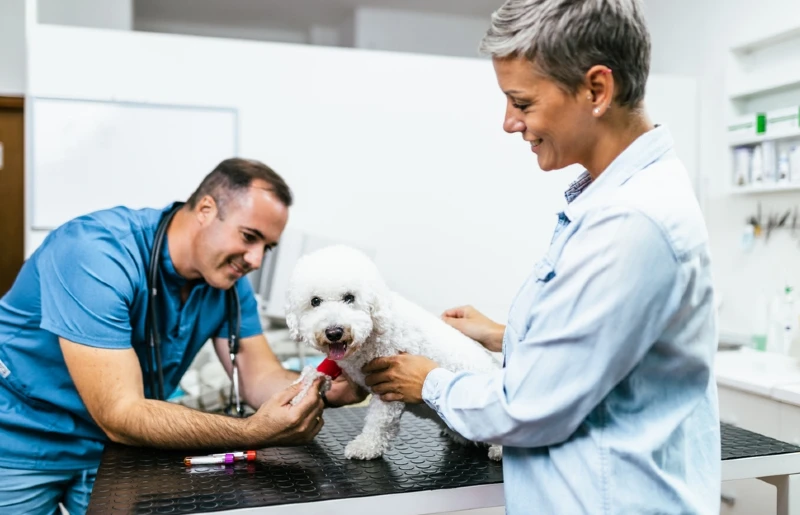
Does Pet Insurance Cover Vet Visits?
Fortunately, pet insurance companies cover basic vet visits as long as you’re up to date with paying premiums and deductibles. You can also select more advanced or customized pet insurance plans that offer coverage for more services, such as x-rays, prescription medication, and care for chronic conditions.
If you have a relatively healthy pet, you can also enroll in wellness plans. For example, Banfield has its own wellness plan program. It’s not pet insurance and acts more like a membership program. By paying an annual fee, you can receive discounted prices for using Banfield products and services .
So, it doesn’t hurt to check if your veterinary clinic offers some sort of membership program to help reduce veterinary costs. It may be a more affordable route if you have a healthy pet and don’t want to get stuck paying premiums for a plan you don’t end up using.
What to Do for Your Pets in Between Vet Visits
Make sure that you receive answers to all the questions you have regarding your pet’s health. Then, be consistent with caring for your pet according to your vet’s instructions. Stay on top of giving your pets routine medication, such as heartworm pills and flea and tick medication. Be vigilant until your next vet visit.
One of the best things you can do is make sure that your pet is staying healthy and active. Pet obesity is an epidemic in the United States. Your pets won’t know the exact nutritional value of the food that you give them and won’t know how to control the amount of food they eat. So, it’s completely the owner’s responsibility to make sure that their pets are eating a healthy diet with appropriate portions and staying away from unhealthy human snacks and junk food.
Pets also rely on their owners to receive ample amounts of exercise. Make sure that your pets all have plenty of enrichment toys to keep them mentally stimulated and have opportunities to roam around and explore. Small pets can benefit from having a playpen where they can step out of their cages and run around.
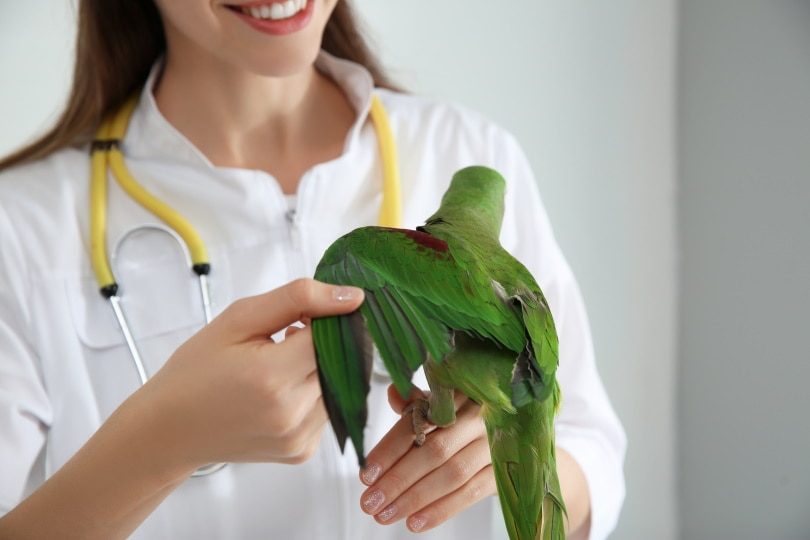
The cost of vet visits will vary based on the type of pet, your pet’s age, and if they’re living with any chronic conditions. Vet visits may seem like unnecessary annual costs at times , but they can actually end up saving you money in the long run. Keeping up with routine vet visits can help screen for illnesses and issues at early stages and help you avoid paying for expensive surgeries.
You can also look into purchasing a pet insurance plan that includes coverage for vet visits. Pet insurance plans can be especially helpful for older pets with more health care needs.
Overall, vet visits are essential for the lifetime of your pet. With the continuous rise of pet ownership and the growth of the pet industry, we’ll most likely see veterinary care change with the demands. It will be interesting to see how costs are affected, and we’ll be sure to keep you in the loop with the latest updates as they arise.
- See also: Lab Newfie Mix: Care, Pictures, Info & More
- https://www.prnewswire.com/news-releases/study-shows-millennials-demand-personalized-care-for-their-pets-to-remain-loyal-to-their-vets-300915777.html
- https://www.aaha.org/publications/newstat/articles/2020-02/pet-obesity-is-an-epidemic/
Featured Image Credit: Veronica Louro, Shutterstock
About the Author
Jessica Kim
Jessica is a freelance writer who spends most of her day researching and writing while her furry companion Cavapoo, Nora, snoozes beside her. She loves pets and animals because there’s so much to learn from them, and they do so much for us. As a dog mom, she understands the strong connection that pet parents have with their pets. So, she loves sharing helpful information that pet owners can use to better understand their pets. When she isn't writing, you may find her walking dogs, tending to her plants, or drinking her nth cup of coffee.

Pet Care Insurance Review 2024: Pros, Cons & Verdict

How to Use Guillotine Dog Nail Clippers: Vet Approved Instructions

Military Dog Hearing Protection: How They Protect Their Ears (Vet Approved)
Get dogster in your inbox.

ESA Doctors Letter Service Review 2024: Our Expert’s Breakdown

Nom Nom Dog Food Subscription Review 2024: Our Expert’s Breakdown
© pangolia pte. ltd. all rights reserved..

September 20, 2018
General care
Health & nutrition
How Much Will a Vet Visit Cost?
Every pet owner knows that vet care is a routine part of being a responsible pet parent, but not every pet parent knows what vet care should cost from basic preventative care and vaccinations to an unexpected diagnosis.
This article gives an overview of what kinds of expenses to expect and what those expenses are so you’re better prepared before heading to the office. Keep in mind that it’s possible for vet costs to vary widely depending on where you live, for example. It’s also a good idea to talk with other trusted pet parents to get their experience of different veterinary care costs.
What Do Veterinarians Charge For?
Most pet parents cringe when it comes to the vet bill part of a vet visit; however, that is because most do not know what goes into the services their pet receives. The reality is that—in addition to administrative and operating fees—there are many things vets have to charge for in their practice. These are:
- Professional services, which includes the physical exam, medical exam, extended exam, and hospitalized patient exam
- Diagnostic services, which includes blood pressure evaluation and more
- Diagnostic imaging services, which could range from ultrasounds to radiographs
- Lab work services, which includes collecting labs, running, and analyzing samples that test for blood chemistry, leukemia, heartworms, thyroid, immunity, and more
- Surgical procedures
- Anesthesia for procedures, which includes intubation and monitoring
- Hospitalization services, which includes overnight stays, inpatient monitoring, and more
Veterinary fees are generally competitive based on the rates of other veterinarians in the surrounding area as well as the nature of the services offered. Your pet’s weight and size also influences costs for services rendered.
Costs of Basic Preventative Care
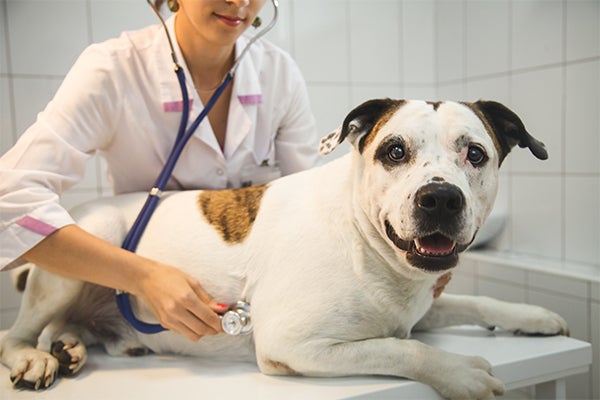
Average cost of physical exam: $45-$55
Some such visits will also include getting routine vaccinations or vaccine boosters. Recommended vaccines for dogs are for parvovirus, distemper, hepatitis, and rabies. Recommended vaccines for cats are panleukopenia, herpesvirus, calcivirus, feline leukemia, and rabies.
Average cost of vaccines per shot: $15-$28
Costs of additional tests and services.
Additional services that might be rendered during a preventative care visit include tests for potential issues such as a fecal exam or heart worm test. The typical costs for such additional tests and services are:
- Fecal exam: $25-$45
- Heartworm test: $45-$50
- Dental cleaning: $70-$400
- Allergy testing: $195-$250 for skin test, $200-$300 for blood test
- Geriatric screening: $85-$110
Costs of Surgery or Unexpected Diagnosis
While on average, routine annual veterinary care might cost between $200 to $400 for dogs and $90 to $200 for cats, unplanned events such as accidents, injuries, or unanticipated ailments can cost a variable amount more.
For example, if you learn your cat has diabetes, it might cost $300 just for your vet to be able to properly diagnose your cat. The total cost of caring for a pet with diabetes will vary depending on the age of the cat when diagnosed and how long the cat lives afterward. While glucose can be monitored and insulin can be managed at home, pets with diabetes often have to visit the vet more frequently for other ailments or for interpreting at-home glucose test results as needed.
Similarly, if, after the $45–$50 heart worm test, your dog does have heart worms, treatment can be $400 to $1,000.
Emergency treatment is another expense that can quickly run upwards of and beyond $1,000. Again, this is circumstantial and depends on what the vet has to do to diagnose and to treat your pet. If the ailment is unknown, the vet will have to do diagnostics and blood work—possibly imaging, to determine what is wrong. After they figure out what is wrong, they still have to treat your pet. If hospitalization is necessary, that will increase the total costs for treatment.
Covering Veterinary Costs

To manage costs, consider creating a special savings account to cover your pet’s annual vet bills plus incidentals. If you start saving while your pet is young, by the time they suffer afflictions typical of old age, you will be financially prepared to handle those unplanned diagnoses as well as any other unexpected medical problems that occur along the way.
In addition to preventative care, pet parents can help decrease unplanned medical issues by feeding a natural food especially designed for his or her size, age and breed. Wellness Pet Food for dogs and cats is made with all-natural ingredients and are created to ensure cats and dogs have long, healthy, happy lives.
Be the best pet parent you can be. Join for expert advice.
We send coupons too!
Share This post
Related products.

Wellness CORE+ Wholesome Grains
Original Turkey & Chicken with Freeze Dried Turkey
WHERE TO BUY

Wellness CORE+ Grain Free
Wild Game Duck, Turkey, Boar & Rabbit

Wellness Complete Health Grain Free
Deboned Chicken & Chicken Meal

Related Blog Articles
Entertainment
Environment
Seasonal Tips
Top 10 Springtime Adventures to Enjoy With Your Dog
Get Outside and Get Active With Your Dog in Spring Happy Active Dog Month! Spring has finally sprung, and your dog is likely leaping out the door to enjoy as many dog friendly activities in the sunshine as possible. Let them—and go with them! Warmer Weather, Fresh Air and Exercise When it comes to dogs […]
Dental Care
How To Deal With Your Dog’s Spring Fever
Notice that your dog has a little extra “pep” in their steps these days as the weather gets warmer and days get longer? If he or she is anything like some of our dogs, they’ve been running in circles in the yard more often, digging up holes in the dirt, and eating some new spring […]
Old Mother Hubbard
6 Ways to Spend Time With Your Dog This Spring
Ah, spring! That wonderful time of year when the sun starts to warm our faces, and the world seems to wake up again. If you’ve got a dog, you know they’re just as excited as you are to shake off the winter blues and get back to exploring. So, take advantage of the nice spring […]
Get exclusive savings, pet care tips and more!
Sign up for our newsletter and stay up to date with all things Wellness ® . Every edition will feature product news, special offers, and exclusive savings. Sign up today!.

IMAGES
VIDEO
COMMENTS
A basic checkup can cost anywhere between $40 and $150, depending on where you live. You may need to see a veterinarian for reasons other than just a checkup, in which case, the cost of seeing the ...
An appointment for surgery will cost much more than a wellness visit, and regular treatments, such as those for cancer, can add up to a considerable sum over time. Here are some of the most common veterinary services and how much they typically cost. Tests, Examinations, and Initial Vet Costs: Routine checkups: $50 to $250.
If you have a $250 deductible and 90% reimbursement level, your out-of-pocket cost for the incident would be $590 ($250 deductible + 10% of $3,400 = $590). Adding up premiums for three years and ...
A routine veterinary exam is a good time to discuss any concerns you may have about your pet's health and to get preventive treatment for common health issues. Procedure. Average Cost. Routine vet visit. $50-$250 3.
How Much Does a Vet Checkup Cost? Below are some typical costs associated with routine wellness care for dogs and cats: Office visit/physical examination: $40 - 90. Panel of screening bloodwork: $50 - 200. Urinalysis: $20 - 60. Fecal examination: $25 - 50. Core vaccines (each): $20 - 45.
A physical exam will cost between $45-$55 for a cat. If your cat needs medication or vaccines, most shots cost an additional $15-$28. For most people, a single trip to the vet will end up costing between $90-$200 for cats, which is nearly half that of a dog. Keep in mind that these prices are for routine, annual vet visits.
Here are some costs you may encounter for a diagnostic vet visit for a dog or cat: X-ray: Up to $250. Fecal exam: $25 to $60. Ultrasound: $300 to $600. Lab tests: $200 to $300. Urine tests: $25 to ...
the cost of veterinary office calls. type of care. potential cost for dogs 🐩. potential cost for cats 🐈. Routine care (including the exam fee) $100-$300. $90-200. ER visit. $100-200.
It could be due to bacteria, mites, yeast, or an unnoticed injury. A vet will examine the area, determine the cause, and recommend treatment, which may include a prescription. As long as the issue doesn't point to a more serious health condition, this visit will typically cost $120-$150.
Here are a few examples of some extra procedures that some cats may require. Tooth Extraction: $50 to $130. Geriatric Screening: $200 to $250. Blood Tests for Allergies in addition to Standard Bloodwork: $300 to $400.
Costs For Emergency Vet Services. Visiting the emergency animal hospital might cost you $500-$1,000 or more, depending on whether you have a cat or a small or large dog and what needs to be done. According to online emergency vet finder Emergency Vets USA, an exam and consultation costs $100-$150; bloodwork, $80-$200; X-rays, $150-$250 ...
How Much Is a Wellness Exam for a Cat? The average cost for a veterinary wellness exam is about $50, but this varies by region. The exam fee covers the physical exam and veterinary consultation but does not include vaccines, lab work, products, or additional services. Keep this in mind when it's time for your cat's annual vet visit.
So, how much is a vet visit for a cat? It varies depending on the location, type of visit, and additional services, but expect to budget anywhere from $50 to $200.
At low-cost vet clinics, you might be charged $50 to $100 for dogs and $50 to $200 for cats. Standard clinics can range from $200 to $400 for dogs and $50 to $200 for cats. (Due to the complexity of the procedure, spaying female cats and dogs is generally more expensive than neutering male pets.) Of course, like with many procedures, there's ...
Without pet insurance, the cost of a routine checkup for your cat can range from $50 to $250. [1] The ASPCA estimates cat owners pay an average of $160 each year for routine medical costs, including an annual visit. [2] The final cost of your cat's visit to the vet will vary based on the exam's outcome.
Price estimator. Don't see a service you need? Just call for more information. Your veterinary team will work with you to provide the right services for your pet. Plus, you may be able to save on services with an Optimum Wellness Plan® (OWP). See OWP packages.
The average cost of a routine veterinary checkup is $25 to $186, according to the pet financing experts at CareCredit . Emergency vet visit costs can range from $374 to $1,285. Connecticut has the ...
The cost of an emergency vet visit varies due to several factors, like location, animal species, breed, size, and the emergency. So, how much is an emergency vet visit? Let's break down the general cost of treatment. Blood work: $80-$250; Exam: $100-$200; Standard imaging: $150-$600; Pain medicine: $40-$80; Hospitalization: $800-$2,500; IV ...
Maria Sbytova / Shutterstock.com. The average cost of cat wellness exam in early 2023 was just over $60. Differences in cost may depend a lot on the region you live in. The average cost for a vet exam by state ranges from about $25 to $186. Living in or close to a large city may also contribute to higher expenses.
There are four basic types of vet check-ups for dogs: office calls, vaccine boosters, heartworm tests, and fecal exams. Each of these types of check-ups has varying costs (depending on your location, specific vet, dog breed, etc.). Office Calls: $45-$55. Vaccine Boosters: $18-$25.
An ER exam could cost between $100 and $200. A broken bone could cost $2,371 for dogs and $2,257 for cats. A foreign object in your pet's stomach could require veterinary care that runs $3,262 for dogs and $2,955 for cats. Blood tests during an emergency vet visit could cost between $80 and $200. An ultrasound at the vet could run between ...
Here are the updated costs of vet visits and what you can expect to pay. As a general overview, basic annual vet visits for cats and dogs are between $35 to $80 and they can go up to $500 for ...
While on average, routine annual veterinary care might cost between $200 to $400 for dogs and $90 to $200 for cats, unplanned events such as accidents, injuries, or unanticipated ailments can cost a variable amount more. For example, if you learn your cat has diabetes, it might cost $300 just for your vet to be able to properly diagnose your cat.